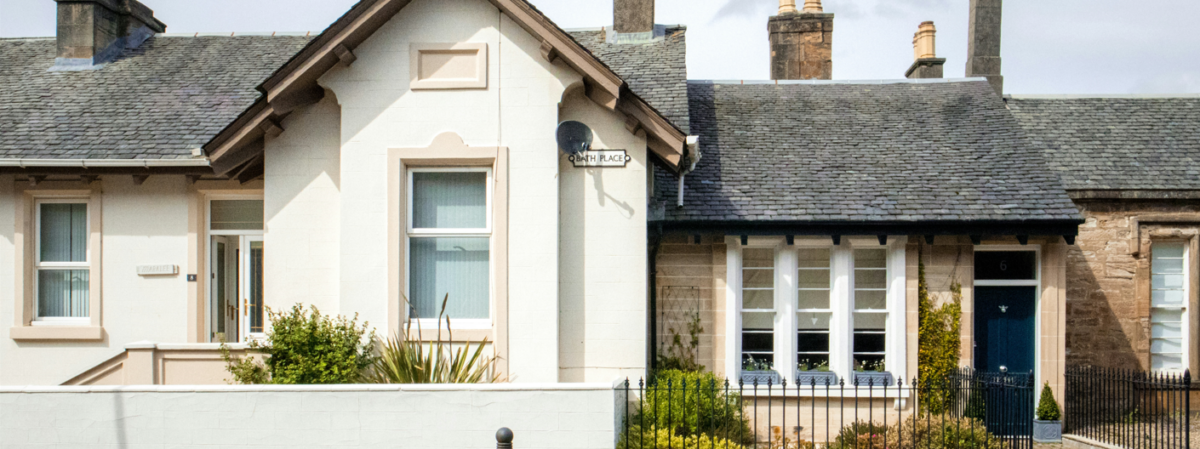October 30, 2024
Northern Ireland has the lowest average house prices in the UK and is the most affordable region for property buyers and investors, but how much does it cost to build a house in Northern Ireland?
To help you budget effectively, we’ve calculated the costs of building a home in Northern Ireland. In addition, we’ve also included to the cost to build other projects, such as an extension, garage, porch, loft conversion, and a bungalow, and we’ve also provided the costs per square metre.
Building A House In Northern Ireland
Our calculations are based on:
- A total floor area of 94m2, which is the average for a house in the UK.
- The average number of bedrooms being 2.95 rooms per house, rounded up to 3.
In terms of build specification, our BuildPartner pricing tool gives you three options (which can be revised by item at a later point):
- Basic spec is a basic finish; e.g. Leyland, Everest, Wickes.
- Standard spec is a standard finish; e.g. Dulux, Hamilton, Slim Line.
- Premium spec is a high-spec finish; e.g. Farrow & Ball, Fine Line, Siemens.
The costs associated with the projects in this guide are calculated according to a standard spec. Then, for each specification, we’ve provided a range of prices to reflect the varying types of contractors:
- Low benchmark – smaller companies are generally lower cost but less specialised and with low project management function; good for low/mid-spec projects and tight budgets.
- Mid benchmark – medium-sized companies offer a balanced mix of cost-effectiveness and specialisation; good for mid-range projects for effective execution within moderate budgets.
- High benchmark – larger companies generally have a higher cost base but can handle a wide variety of specialist tasks; good for mid/high-spec projects and project management.
Total Cost Of A Standard-Spec Build In Northern Ireland
Here’s a table showing the average costs of building a house and other projects in Northern Ireland:
|
Building Type |
Total Average Building Cost |
||
|
Low Benchmark |
Mid Benchmark |
High Benchmark |
|
|
3-Bedroom House |
£234,931 |
£261,798 |
£283,614 |
|
Ground-Floor Extension |
£66,730 |
£71,528 |
£77,489 |
|
Double-Storey Extension |
£116,541 |
£124,952 |
£135,365 |
|
Single Garage (Flat Roof) |
£21,378 |
£22,960 |
£24,873 |
|
Brick Porch |
£6,565 |
£7,627 |
£7,040 |
|
2-Bed Bungalow |
£149,446 |
£160,273 |
£173,630 |
|
Standard Loft Conversion |
£44,087 |
£46,821 |
£50,722 |
Total Cost Per Square Metre In Northern Ireland
Here’s a table showing the costs per square metre of building a house and other projects in Northern Ireland:
|
Building Type |
Average Cost Per Sq Metre |
||
|
Low Benchmark |
Mid Benchmark |
High Benchmark |
|
|
3-Bedroom House |
£2,136 |
£2,380 |
£2,578 |
|
Ground-Floor Extension |
£2,186 |
£2,384 |
£2,583 |
|
Double-Storey Extension |
£1,909 |
£2,083 |
£2,256 |
|
Single Garage (Flat Roof) |
£1,276 |
£1,392 |
£1,507 |
|
Brick Porch |
£2,151 |
£2,542 |
£2,347 |
|
2-Bed Bungalow |
£1,632 |
£1,781 |
£1,929 |
|
Standard Loft Conversion |
£1,431 |
£1,561 |
£1,691 |
All costs exclude VAT.
The Average Cost To Build A House In Northern Ireland
So, how much does it cost to build a house in Northern Ireland? Based on a standard specification for a typical three-bedroom house, you can expect to pay £261,798, not including the price of land. This figure covers construction expenses like materials and labour but does not include the cost of land.
However, a lack of land, a sluggish planning system, and infrastructure challenges mean that developers are looking to expand elsewhere in the UK. But with “incredible scarcity, property prices and rents are going to continue to go up,” says Conor Mulligan of Lagan Homes.
Frequently Asked Questions About House Building In Northern Ireland
Here are a few questions that provide extra insight into the cost of building a house in Northern Ireland.
What is the average house price in Northern Ireland?
According to the Northern Ireland House Price Index, the average house price in Northern Ireland is £185,025. The average ranges from £163,836 in Derry City and Strabane to £215,464 in Lisburn and Castlereagh. The average price in the capital, Belfast, is £168,054.
Why has housebuilding in Northern Ireland hit a 60-year low?
The biggest issue relates to its infrastructure: Northern Ireland’s water capacity constraints. Plans for an estimated 19,000 homes in 23 towns are being held up due to an outdated and at-capacity sewage network. Whether development is allowed varies by area; in some places, it is permitted, in others, it may be allowed at additional cost, and in certain locations, it’s all but prohibited.
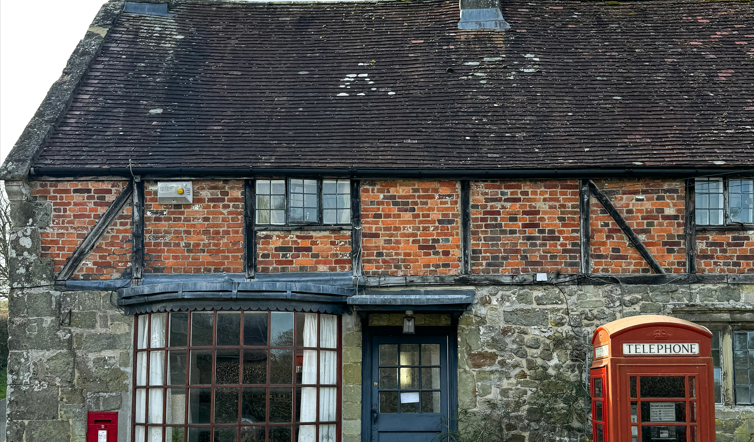
October 30, 2024
Housebuilding costs are soaring, and England is no exception. The number one challenge, according to the Chief Executive of Barratt Homes, is the shortage of skilled tradespeople. Couple that with inflation for materials, and you have a perfect storm for driving up construction costs, adding complexity to an already challenging housing market in England.
To help you plan effectively, we’ve calculated the costs of building a home in England and other projects, including an extension, garage, porch, loft conversion, and bungalow, and we’ve also provided the costs per square metre.
Building A House In England
Our calculations are based on:
- A total floor area of 94m2, which is the average for a house in England.
- The average number of bedrooms being 2.95 rooms per house, rounded up to 3.
In terms of build specification, our BuildPartner pricing tool gives you three options (which can be revised by item at a later point):
- Basic spec is a basic finish; e.g. Leyland, Everest, Wickes.
- Standard spec is a standard finish; e.g. Dulux, Hamilton, Slim Line.
- Premium spec is a high-spec finish; e.g. Farrow & Ball, Fine Line, Siemens.
The costs associated with the projects in this guide are calculated according to a standard spec. Then, for each specification, we’ve provided a range of prices to reflect the varying types of contractors:
- Low benchmark – smaller companies are generally lower cost but less specialised and with low project management function; good for low/mid-spec projects and tight budgets.
- Mid benchmark – medium-sized companies offer a balanced mix of cost-effectiveness and specialisation; good for mid-range projects for effective execution within moderate budgets.
- High benchmark – larger companies generally have a higher cost base but can handle a wide variety of specialist tasks; good for mid/high-spec projects and project management.
Total Cost Of A Standard-Spec Build In England
Here’s a table showing the average costs of building a house and other projects in England:
|
Construction Project Type |
Total Average Building Cost |
||
|
Low Benchmark |
Mid Benchmark |
High Benchmark |
|
|
3-Bedroom House |
£263,310 |
£288,688 |
£315,283 |
|
Ground-Floor Extension |
£71,853 |
£80,154 |
£87,641 |
|
Double-Storey Extension |
£125,442 |
£139,765 |
£152,928 |
|
Single Garage (Flat Roof) |
£23,184 |
£25,581 |
£28,185 |
|
Brick Porch |
£7,092 |
£7,900 |
£8,660 |
|
2-Bed Bungalow |
£160,018 |
£178,397 |
£195,657 |
|
Standard Loft Conversion |
£48,666 |
£53,294 |
£59,100 |
Total Cost Per Square Metre In England
Here’s a table showing the costs per square metre of building a house and other projects in England:
|
Construction Project Type |
Average Cost Per Sq Metre |
||
|
Low Benchmark |
Mid Benchmark |
High Benchmark |
|
|
3-Bedroom House |
£2,394 |
£2,624 |
£2,866 |
|
Ground-Floor Extension |
£2,565 |
£2,672 |
£2,921 |
|
Double-Storey Extension |
£2,093 |
£2,329 |
£2,549 |
|
Single Garage (Flat Roof) |
£1,408 |
£1,550 |
£1,708 |
|
Brick Porch |
£2,404 |
£2,674 |
£2,925 |
|
2-Bed Bungalow |
£1,808 |
£2,012 |
£2,203 |
|
Standard Loft Conversion |
£1,651 |
£1,825 |
£1,997 |
All costs exclude VAT.
The Average Cost To Build A House In England
So, how much does it cost to build a house in England? Based on a standard specification for a typical three-bedroom house, you can expect to pay £288,688, not including the price of land. This figure covers construction expenses like materials and labour but does not include the cost of land.
In areas like London or the South East, prices are typically around 20% higher, while costs in the North are generally more affordable. If you’d like to see a breakdown by region, check out this article.
Frequently Asked Questions About House Building In England
Here are a few questions that provide extra insight into the cost of building a house in England.
How much does it cost to apply for Building Regulations in England?
The average cost for a full plan application for one dwelling is £860. To get an exact cost, you’ll need to find the information on your local authority’s website.
How much stamp duty will I pay when building a house in England?
You don’t pay Stamp Duty Land Tax (SDLT) on the cost of building the house, but you will pay SDLT when purchasing the land, which depends on the purchase price of the land. If the land costs less than £250,000 (as of 2024), you won’t owe any stamp duty.
As of 2024, you’ll pay 5% on any purchase between £250,000 to £925,000, 10% on an amount between £925,000 and £1.5 million, an 12% on anything greater than £1.5 million.
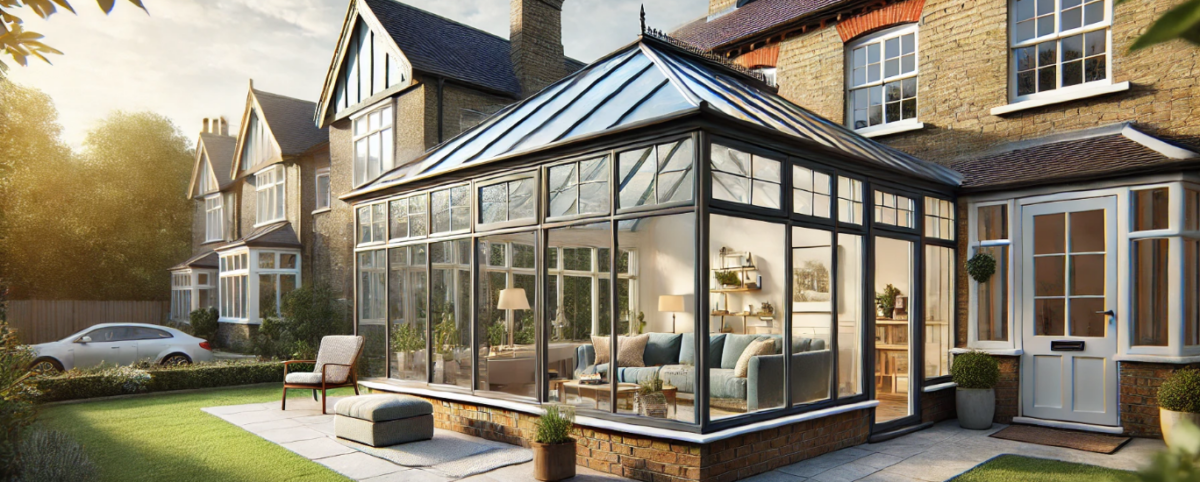
September 30, 2024
If you’re looking to add some extra space and value to your property, a conservatory is often cheaper than building an extension. But how much does it cost to build a conservatory in the UK?
In this article, we’ve covered the costs of building three types of conservatories across multiple regions in the UK, and we’ve also provided a breakdown of the construction costs by stage as well as the costs per square metre.
Start your free trial with BuildPartner today to get the most accurate estimate of building a conservatory based on your own dimensions and specifications.
Conservatory Cost Considerations
Our calculations are based on a 4 x 3m conservatory (12m2). The three main types of conservatory covered in this article include:
- Conservatory with a reinforced glass roof.
- Conservatory with slate roof tiles – including roof structure, insulation, plasterboard, decoration, light fittings, etc.
- Orangery with glass roof – including brick wall, cavity insulation, plasterboard, decoration, etc.
The costs do not include additional heating, such as radiators or underfloor heating.
Build Specifications and Supplier Benchmarks
In terms of build specification, our BuildPartner pricing tool gives you three options (which can be revised by item at a later point):
- Basic spec is a basic finish; e.g. Leyland, Everest, Wickes.
- Standard spec is a standard finish; e.g. Dulux, Hamilton, Slim Line.
- Premium spec is a high-spec finish; e.g. Farrow & Ball, Fine Line, Siemens.
For this particular cost breakdown, we have selected standard spec. In addition, for each specification, we’ve provided a range of prices to reflect the varying types of contractors:
- Low benchmark – smaller companies are generally lower cost but less specialised and with low project management function; good for low/mid-spec projects and tight budgets.
- Mid benchmark – medium-sized companies offer a balanced mix of cost-effectiveness and specialisation; good for mid-range projects for effective execution within moderate budgets.
- High benchmark – larger companies generally have a higher cost base but can handle a wide variety of specialist tasks; good for mid/high-spec projects and project management.
Cost Of Building A Glass Roof Conservatory
Here’s a table showing the average cost of building a conservatory for a standard-spec project in the UK:
| Conservatory – Structural Glass Roof | Total Average Build Cost | Average Cost Per Sq Metre | ||||
| Low Benchmark | Mid Benchmark | High Benchmark | Low Benchmark | Mid Benchmark | High Benchmark | |
| East Anglia | £32,707 | £35,680 | £38,653 | £2,726 | £2,973 | £3,221 |
| London | £34,690 | £38,790 | £42,574 | £2,891 | £3,232 | £3,548 |
| Midlands | £32,404 | £35,350 | £38,295 | £2,700 | £2,946 | £3,191 |
| North England | £32,150 | £35,203 | £38,136 | £2,679 | £2,934 | £3,178 |
| Northern Ireland | £31,974 | £34,660 | £37,548 | £2,648 | £2,888 | £3,129 |
| Scotland | £32,175 | £35,101 | £38,026 | £2,681 | £2,925 | £3,169 |
| South East | £31,915 | £35,686 | £39,594 | £2,891 | £3,232 | £3,548 |
| South West | £32,557 | £36,572 | £40,140 | £2,726 | £3,048 | £3,345 |
| Wales | £32,407 | £36,236 | £38,531 | £2,701 | £3,020 | £3,211 |
| Average | £32,553 | £35,920 | £39,055 | £2,738 | £3,022 | £3,282 |
All costs exclude VAT.
Here’s what the data shows for the cost of building a glass roof conservatory to a standard spec:
- The minimum cost is £31,915, and the maximum cost is £42,574.
- The total average cost is £35,843, or £3,014 per square metre.
Building Cost Breakdown By Project Stage – London
Here’s an example of the associated costs for the different stages of building a glass roof conservatory for a standard-spec project – when using a mid-benchmark contractor in London:
| Total | £38,790 | 100% |
| Roof structure and coverings | £17,174 | 44.3% |
| External windows and doors | £9,945 | 25.6% |
| Preliminaries | £5,302 | 13.7% |
| Foundations and substructure | £3,342 | 8.6% |
| Floor structure and lining | £1,581 | 4.1% |
| Drainage and pipework | £693 | 1.8% |
| Demolitions | £310 | 0.8% |
| External wall structure and lining | £225 | 0.6% |
| Wiring and fuseboards | £218 | 0.6% |
The cost of the roof structure for a reinforced glass roof is much higher when compared to a standard roof structure with slate tiles – due mainly to the high cost of reinforced glass.
Cost Of Building A Tiled Roof Conservatory
Here’s a table showing the average cost of building a tiled roof conservatory for a standard-spec project in the UK:
| Conservatory – Slate Roof Tiles | Total Average Build Cost | Average Cost Per Sq Metre | ||||
| Low Benchmark | Mid Benchmark | High Benchmark | Low Benchmark | Mid Benchmark | High Benchmark | |
| East Anglia | £19,709 | £21,500 | £23,292 | £1,642 | £1,792 | £1,941 |
| London | £21,750 | £24,321 | £26,693 | £1,813 | £2,027 | £2,224 |
| Midlands | £19,399 | £21,162 | £22,926 | £1,617 | £1,764 | £1,910 |
| North England | £19,142 | £21,012 | £22,763 | £1,595 | £1,751 | £1,897 |
| Northern Ireland | £18,957 | £20,456 | £22,160 | £1,563 | £1,705 | £1,847 |
| Scotland | £19,164 | £20,906 | £22,648 | £1,597 | £1,742 | £1,887 |
| South East | £20,010 | £22,375 | £24,558 | £1,813 | £2,027 | £2,224 |
| South West | £19,555 | £22,038 | £24,188 | £1,642 | £1,836 | £2,016 |
| Wales | £19,402 | £21,694 | £23,167 | £1,617 | £1,808 | £1,931 |
| Average | £19,676 | £21,718 | £23,599 | £1,655 | £1,828 | £1,986 |
All costs exclude VAT.
Here’s what the data shows for the cost of building a tiled roof conservatory to a standard spec:
- The minimum cost is £18,957, and the maximum cost is £26,693.
- The total average cost is £21,665, or £1,823 per square metre.
Building Cost Breakdown By Project Stage – London
Here’s an example of the associated costs for the different stages of building a tiled roof conservatory for a standard-spec project – when using a mid-benchmark contractor in London:
| Total | £24,321 | 100% |
| External windows and doors | £9,945 | 40.9% |
| Preliminaries | £5,302 | 21.8% |
| Foundations and substructure | £3,342 | 13.7% |
| Roof structure and coverings | £2,242 | 9.2% |
| Floor structure and lining | £1,581 | 6.5% |
| Drainage and pipework | £693 | 2.8% |
| Ceiling structure and lining | £464 | 1.9% |
| Demolitions | £310 | 1.3% |
| External wall structure and lining | £225 | 0.9% |
| Wiring and fuseboards | £218 | 0.9% |
Cost Of Building An Orangery
Here’s a table showing the average cost of building an orangery for a standard-spec project in the UK:
| Orangery – Structural Glass Roof | Total Average Build Cost | Average Cost Per Sq Metre | ||||
| Low Benchmark | Mid Benchmark | High Benchmark | Low Benchmark | Mid Benchmark | High Benchmark | |
| East Anglia | £35,866 | £39,126 | £42,387 | £2,989 | £3,261 | £3,532 |
| London | £38,473 | £43,020 | £47,217 | £3,206 | £3,585 | £3,935 |
| Midlands | £35,483 | £38,709 | £41,934 | £2,957 | £3,226 | £3,495 |
| North England | £35,194 | £38,523 | £41,734 | £2,933 | £3,210 | £3,478 |
| Northern Ireland | £34,490 | £37,753 | £40,899 | £2,874 | £3,146 | £3,408 |
| Scotland | £35,175 | £38,373 | £41,571 | £2,931 | £3,198 | £3,464 |
| South East | £35,396 | £39,579 | £43,912 | £2,950 | £3,298 | £3,659 |
| South West | £35,676 | £40,104 | £44,017 | £2,973 | £3,342 | £3,668 |
| Wales | £35,486 | £39,679 | £42,234 | £2,957 | £3,307 | £3,519 |
| Average | £35,693 | £39,430 | £42,878 | £2,974 | £3,286 | £3,573 |
All costs exclude VAT.
Here’s what the data shows for the cost of building an orangery to a standard spec:
- The minimum cost is £34,490, and the maximum cost is £47,217.
- The total average cost is £39,334, or £3,278 per square metre.
Building Cost Breakdown By Project Stage – London
Here’s an example of the associated costs for the different stages of building an orangery for a standard-spec project – when using a mid-benchmark contractor in London:
| Total | £43,020 | 100% |
| Roof structure and coverings | £17,174 | 39.9% |
| External windows and doors | £9,945 | 23.1% |
| Preliminaries | £5,487 | 12.8% |
| External wall structure and lining | £3,785 | 8.8% |
| Foundations and substructure | £3,342 | 7.8% |
| Floor structure and lining | £1,581 | 3.7% |
| Drainage and pipework | £693 | 1.6% |
| Decoration | £486 | 1.1% |
| Demolitions | £310 | 0.7% |
| Wiring and fuseboards | £218 | 0.5% |
Summary Of The Average Cost To Build A Conservatory
So, how much does it cost to build a conservatory in the UK? Based on the two types covered in this article, you can expect it to cost on average (when using a mid-benchmark contractor):
- Conservatory with structural glass roof – £35,920, or £3,022 per sq metre.
- Conservatory with slate roof tiles – £21,718, or £1,828 per sq metre.
- Orangery with structural glass roof – £39,430, or £3,286 per sq metre.
Depending on the specifications, the cost of the work for a conservatory build would range between £18,957 and £47,217.
Please remember that these costs do not include VAT, and there may be other additional costs, such as obtaining planning permission, conducting structural surveys, making unexpected repairs, and completing custom finishes.
Start your free trial with BuildPartner today to get the most accurate estimate of building a conservatory based on your own dimensions and specifications.
Frequently Asked Questions About Conservatories
Here are a few questions about building conservatories in the UK.
What’s the difference between a conservatory and an orangery?
An orangery is fundamentally a brick structure with large glass windows and roofing, which provides more insulation than a fully glazed conservatory.
How can I make a conservatory more energy-efficient?
To make a conservatory more energy efficient, use triple glazing, install a tiled roof, and consider underfloor heating or energy-efficient radiators. Using blinds also regulates temperature.
Do I need planning permission for a conservatory?
Planning permission is generally not required for a conservatory if it meets permitted development rights. Your conservatory must be at the rear of the house, less than four metres high, less than 50% of the area of the land around the house, and its walls must run within the length of the property’s walls.

August 28, 2024
Renovating a flat in the UK requires careful cost planning and budgeting. In this 2024 guide, we provide a comprehensive cost breakdown of a 1-bedroom and 2-bedroom flat, and we also break the cost down per square metre.
Whether you’re undertaking a full-scale refurbishment or focusing on specific areas like the kitchen or bathroom, this guide furnishes you with the insights needed to navigate your renovation project.
Key Factors Affecting Flat Renovation Costs
When renovating a flat, several key factors come into play that significantly impact the overall cost. Firstly, the median floor space of the average UK flat is 58m2, so our calculations are based on a 2-bedroom flat of 64m2 and a 1-bedroom flat of 52m2, with both comprising an open-plan kitchen and living room and a bathroom.
Our cost breakdown includes all appliances, such as a built-in dishwasher, fridge, freezer, washing machine, extractor fan, hob, and oven. The only exclusion is a central heating boiler; however, radiators are included.
It’s also important to distinguish between a renovation and a remodel. A renovation focuses exclusively on replacing the finishings and fittings in their existing locations and does not involve changing the layout of a structure.
Build Specifications & Supplier Benchmarks
In terms of build specifications, our BuildPartner pricing tool gives you three options when creating your quote (which can be revised by item at a later point):
- Basic spec is a basic finish; e.g., Leyland, Everest, Wickes.
- Standard spec is a standard finish; e.g., Dulux, Hamilton, Slim Line.
- Premium spec is a high-spec finish; e.g., Farrow & Ball, Fine Line, Siemens.
For each renovation type (1-bed and 2-bed flat), we’ve provided a range of prices to reflect the varying types of contractors:
- Low benchmark – smaller companies are generally lower cost but less specialised and with low project management function; good for low/mid-spec projects and tight budgets.
- Mid benchmark – medium-sized companies offer a balanced mix of cost-effectiveness and specialisation; good for mid-range projects for effective execution within moderate budgets.
- High benchmark – larger companies generally have a higher cost base but can handle a wide variety of specialist tasks; good for mid/high-spec projects and project management.
Cost Of A 2-Bedroom Flat Renovation
Here’s a table showing the average building costs of renovating a 2-bed flat for a standard-spec project in the UK:
| 2-Bedroom Flat Refurb | Total Average Build Cost | Average Cost Per Sq Metre | ||||
| Low Benchmark | Mid Benchmark | High Benchmark | Low Benchmark | Mid Benchmark | High Benchmark | |
| East Anglia | £33,602 | £36,657 | £39,711 | £525 | £573 | £620 |
| London | £37,306 | £42,268 | £46,413 | £583 | £660 | £725 |
| Midlands | £32,998 | £35,998 | £38,998 | £516 | £562 | £609 |
| North England | £32,864 | £35,852 | £38,840 | £514 | £560 | £607 |
| Northern Ireland | £32,410 | £34,781 | £37,680 | £498 | £543 | £589 |
| Scotland | £32,937 | £35,931 | £38,925 | £515 | £561 | £608 |
| South East | £34,321 | £38,377 | £42,579 | £583 | £652 | £715 |
| South West | £33,329 | £37,573 | £41,239 | £525 | £587 | £644 |
| Wales | £33,056 | £36,962 | £39,520 | £516 | £578 | £618 |
| Average | £33,647 | £37,156 | £40,434 | £530 | £586 | £637 |
All costs exclude VAT.
Here’s what the data shows for the cost of fully renovating a 2-bed flat to a standard spec:
- It costs 15% more to renovate a 2-bed flat in London than in other regions.
- The minimum cost is £32,410, and the maximum cost is £46,413.
- The total average cost is £37,079, or £585 per square metre.
2-Bed Flat Renovation Cost Breakdown – London
Here’s an example of the associated costs for the different stages of a renovation for a standard-spec project – when using a mid-benchmark contractor in London:
| Total | £42,268 | 100.0% |
| Demolitions | £1,464 | 3.5% |
| Heating and cooling | £1,384 | 3.3% |
| Plumbed appliances | £3,916 | 9.3% |
| Wired appliances | £4,932 | 11.7% |
| Ceiling preparation and finishes | £549 | 1.2% |
| Wall preparation and finishes | £3,797 | 9.0% |
| Floor preparation and finishes | £9,274 | 21.9% |
| Units, worktops and kitchen appliances | £16,528 | 39.1% |
| Fixtures and fittings | £425 | 1.0% |
And here’s a breakdown of the associated costs by room for a standard-spec renovation project – when using a mid-benchmark contractor in London:
| Total | £42,268 | 100% |
| Bathroom | £9,836 | 23.3% |
| Bedroom 1 | £4,332 | 10.2% |
| Bedroom 2 | £3,795 | 9.0% |
| Kitchen / Living / Dining | £24,306 | 57.5% |
Remember, appliances are included in the costs, which is why the kitchen accounts for a disproportionate amount of the total expense.
Cost Of A 1-Bedroom Flat Renovation
Here’s a table showing the average building costs of fully renovating a 1-bed flat for a standard-spec project in the UK:
| 1-Bedroom Flat Refurb | Total Average Build Cost | Average Cost Per Sq Metre | ||||
| Low Benchmark | Mid Benchmark | High Benchmark | Low Benchmark | Mid Benchmark | High Benchmark | |
| East Anglia | £30,685 | £33,475 | £36,264 | £590 | £644 | £697 |
| London | £33,912 | £38,474 | £42,248 | £652 | £740 | £812 |
| Midlands | £30,184 | £32,928 | £35,672 | £580 | £633 | £686 |
| North England | £30,068 | £32,801 | £35,535 | £578 | £631 | £683 |
| Northern Ireland | £29,675 | £31,890 | £34,548 | £562 | £613 | £664 |
| Scotland | £30,118 | £32,855 | £35,593 | £579 | £632 | £684 |
| South East | £31,199 | £34,886 | £38,290 | £652 | £729 | £800 |
| South West | £30,455 | £34,311 | £37,659 | £590 | £660 | £724 |
| Wales | £30,226 | £33,798 | £36,108 | £581 | £650 | £694 |
| Average | £30,725 | £33,935 | £36,880 | £596 | £659 | £716 |
All costs exclude VAT.
Here’s what the data shows for the cost of fully renovating a 1-bed flat to a standard spec:
- The minimum cost is £29,675, and the maximum cost is £42,248.
- The total average cost is £33,847, or £657 per square metre.
1-Bed Flat Renovation Cost Breakdown – London
Here’s an example of the associated costs for the different stages of a renovation for a standard-spec project – when using a mid-benchmark contractor in London:
| Total | £36,304 | 100.0% |
| Demolitions | £944 | 2.6% |
| Heating and cooling | £789 | 2.2% |
| Plumbed appliances | £3,711 | 10.2% |
| Wired appliances | £3,278 | 9.0% |
| Ceiling preparation and finishes | £371 | 1.0% |
| Wall preparation and finishes | £3,307 | 9.1% |
| Floor preparation and finishes | £7,673 | 21.1% |
| Units, worktops and kitchen appliances | £15,810 | 43.5% |
| Fixtures and fittings | £422 | 1.2% |
And here’s a breakdown of the associated costs by room for a standard-spec renovation project – when using a mid-benchmark contractor in London:
| Total | £36,304 | 100% |
| Bathroom | £9,147 | 25.2% |
| Bedroom | £4,088 | 11.3% |
| Kitchen / Living / Dining | £23,070 | 63.5% |
Summary Of The Average Cost To Renovate A Flat In The UK
So, how much does a flat renovation cost in the UK? Based on the three different types of contractors, renovating a 2-bedroom flat (64m2) will cost you on average:
- Low benchmark contactor – £33,647, or £530 per sq metre.
- Mid-benchmark contactor – £37,156, or £586 per sq metre.
- High-benchmark contractor – £40,434, or £637 per sq metre.
Depending on the specifications, the cost of the renovation work will typically range between £32,410 and £46,413 for a 2-bedroom flat.
Please remember that these costs do not include VAT, and there may be other additional costs, such as structural surveys, unexpected repairs, and custom finishes.
Frequently Asked Questions About Flat Renovations
Here are a few questions that shed some light on UK flat renovations.
How long does a flat renovation take?
Based on a 2-bedroom flat comprising an open-plan kitchen-living room and a bathroom, a renovation would take approximately four weeks.
This is based on two tradespeople carrying out the scheduled work (demolitions, heating and cooling, wall preparation, floor preparation, plumbed and wired appliances, kitchen units, decoration, and fixtures and fittings).

What is the most common pitfall when renovating a flat?
Since many flats are leasehold, they tend to have strict rules governing when noisy work can take place, often restricting it to specific hours on weekdays and prohibiting it altogether on weekends or evenings. It’s better to adhere to these to avoid potential conflicts and complaints.
Do I have to let my neighbour know before starting work?
If your renovation affects a shared or adjoining wall, you must notify your neighbour under the Party Wall Act 1996. A Party Wall Notice should be given at least two months before major work begins. Your neighbour then has 14 days to consent or request a Party Wall Agreement. Failing to notify them can lead to legal issues and project delays.
Do I need planning permission for a flat renovation?
Most internal renovations do not require planning permission, but you may need approval if you’re making structural changes, especially in listed buildings or conservation areas.
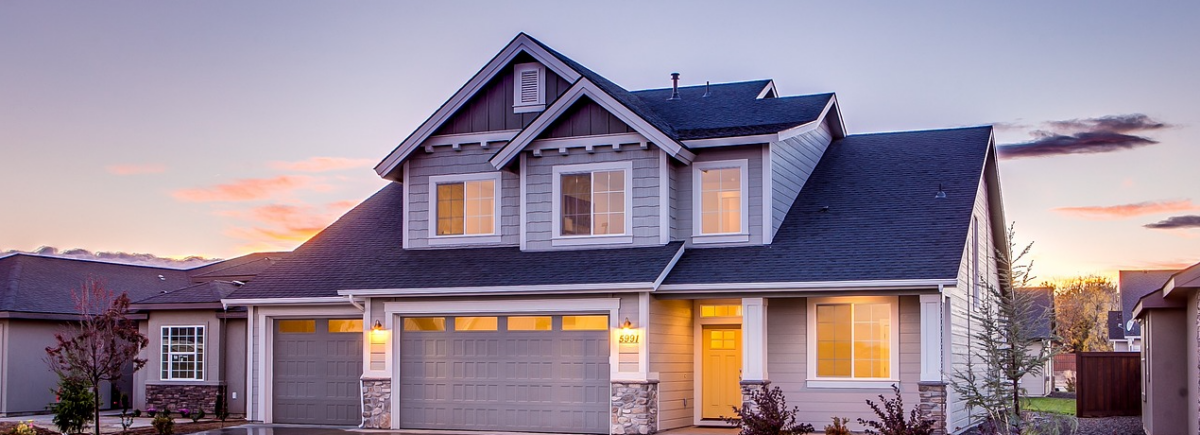
August 30, 2024
When calculating the cost of a loft conversion in the UK, several factors come into play that can significantly impact the final price. From the size of the space and the type of conversion—such as a Mansard or dormer extension—to additional features like en-suites or balconies, each element contributes to the overall building costs.
In this article, we’ll explore some of these variables and how they affect a project’s cost, to help you budget and plan your loft conversion.
10 Main Types of Loft Conversions
Before we take a look at the numbers, it’s important to be aware of the main options available when planning a loft conversion. Each type offers unique benefits and can significantly impact the overall cost and design of your project. Here are eight to be aware of:
- Velux Loft Conversion – The simplest and most cost-effective option, involving the installation of Velux windows into the existing roof space without altering the roof structure.
- Dormer Loft Conversion – Extending the roof outward to create additional space and headroom; they can be full-width or smaller, depending on the space requirements.
- Mansard Loft Conversion – Altering the roof structure to create a near-vertical wall with a flat roof, providing maximum space and headroom.
- Hip-to-Gable Loft Conversion – Replacing the sloping side of the roof with a vertical gable end, effectively increasing the roof space and headroom.
- Gable-to-Gable Loft Conversion – Similar to hip-to-gable, but it extends the existing gable end across the entire width of the property.
- Shell Loft Conversion – Provides the basic structure and space, leaving the interior finishes and fittings to the homeowner.
- Roof Lift Loft Conversion – Raising the entire roof structure to create additional headroom and floor space, often involving significant structural alterations.
- Modular Loft Conversion – A prefabricated solution where sections of the loft are constructed off-site and then assembled on your property.
- Piggyback Loft Conversion – Building an entirely new structure on top of the existing roof, effectively adding a new storey to the property
- Standard Loft Conversion – Predominantly internal work without major changes like roof lifts or complete rebuilds.
In this article, we’ll be reviewing three loft conversion types: a standard loft conversion, a dormer loft conversion, and a Mansard loft conversion. A dormer loft conversion often comprises a single window, two windows, or the full width of the roof.
Considerations For Converting A Loft
A fully finished attic is roughly 35–50% of the house’s ground floor square meterage, so we based our calculations on a floor space of 30m2.
In addition to the total costs, we’ve also provided costs per square metre, so you can carry out your own calculations if you happen to know the dimensions you’re working with.
All our calculations are based on a loft conversion comprising the following:
- Master bedroom
- En-suite bathroom
- Eaves storage
- Landing including stairs
In terms of build specification, our BuildPartner pricing tool gives you three options (which can be revised by item at a later point):
- Basic spec is a basic finish; e.g. Leyland, Everest, Wickes.
- Standard spec is a standard finish; e.g. Dulux, Hamilton, Slim Line.
- Premium spec is a high-spec finish; e.g. Farrow & Ball, Fine Line, Siemens.
In this cost comparison article, we review projects based on a standard spec. In addition to specification, we’ve provided a range of prices to reflect the varying types of contractors:
- Low benchmark – smaller companies are generally lower cost but less specialised and with low project management function; good for low/mid-spec projects and tight budgets.
- Mid benchmark – medium-sized companies offer a balanced mix of cost-effectiveness and specialisation; good for mid-range projects for effective execution within moderate budgets.
- High benchmark – larger companies generally have a higher cost base but can handle a wide variety of specialist tasks; good for mid/high-spec projects and project management.
Standard Loft Conversion
Here’s a table showing the average costs of a standard loft conversion for a standard-spec project in the UK:
| Standard Loft Conversion | Total Average Build Cost | Average Cost Per Sq Metre | ||||
| Low Benchmark | Mid Benchmark | High Benchmark | Low Benchmark | Mid Benchmark | High Benchmark | |
| East Anglia | £47,242 | £51,537 | £55,831 | £1,575 | £1,718 | £1,861 |
| London | £55,780 | £62,375 | £69,410 | £1,859 | £2,079 | £2,314 |
| Midlands | £45,774 | £49,935 | £54,096 | £1,526 | £1,664 | £1,803 |
| North England | £45,358 | £49,493 | £53,618 | £1,512 | £1,650 | £1,787 |
| Northern Ireland | £44,087 | £46,821 | £50,722 | £1,431 | £1,561 | £1,691 |
| Scotland | £45,256 | £49,370 | £53,484 | £1,509 | £1,646 | £1,783 |
| South East | £51,317 | £57,382 | £63,665 | £1,859 | £2,079 | £2,282 |
| South West | £46,528 | £52,825 | £57,979 | £1,575 | £1,761 | £1,933 |
| Wales | £45,815 | £51,229 | £55,279 | £1,527 | £1,708 | £1,843 |
| Average | £47,462 | £52,330 | £57,120 | £1,597 | £1,763 | £1,922 |
All costs exclude VAT.
Here’s what the data shows for the cost of standard loft conversion to a standard spec:
- It costs 23% more to convert a loft in London than in other regions.
- The minimum cost is £44,087, and the maximum cost is £69,410.
- The total average cost is £52,304, or £1,760 per square metre.
Cost Breakdown By Project Stage – London
Here’s an example of the associated costs for the different stages of a standard loft conversion for a standard-spec project – when using a mid-benchmark contractor in London:
| Total | £62,375 | 100% |
| Preliminaries | £10,900 | 17.5% |
| Demolitions | £1,679 | 2.7% |
| Floor structure and lining | £3,460 | 5.5% |
| Steel and structural supports | £5,735 | 9.2% |
| External wall structure and lining | £5,524 | 8.9% |
| Internal wall structure and lining | £3,855 | 6.2% |
| Ceiling structure and lining | £3,901 | 6.3% |
| External windows and doors | £3,070 | 4.9% |
| Internal doors and frames | £1,496 | 2.4% |
| Drainage and pipework | £782 | 1.3% |
| Heating and cooling | £1,643 | 2.6% |
| Wiring and fuseboards | £1,445 | 2.3% |
| Stairs, balustrades and lifts | £2,885 | 4.6% |
| Plumbed appliances | £2,742 | 4.4% |
| Wired appliances | £2,057 | 3.3% |
| Ceiling preparation and finishes | £426 | 0.7% |
| Wall preparation and finishes | £3,720 | 6.0% |
| Floor preparation and finishes | £3,452 | 5.5% |
| Decoration | £3,177 | 5.1% |
| Fixtures and fittings | £425 | 0.7% |
Cost Breakdown By Area – London
Here’s a breakdown of the associated costs by area for a standard-spec loft conversion – when using a mid-benchmark contractor in London:
| Total | £62,375 | 100% |
| Bedroom | £8,378 | 13.4% |
| Eaves storage | £1,492 | 2.4% |
| En-suite | £11,646 | 18.7% |
| Loft conversion | £36,720 | 58.9% |
| Landing incl. stairs | £4,139 | 6.6% |
Mansard Loft Conversion
Here’s a table showing the average building costs of carrying out a Mansard loft conversion for a standard-spec project in the UK:
| Mansard Loft Conversion | Total Average Build Cost | Average Cost Per Sq Metre | ||||
| Low Benchmark | Mid Benchmark | High Benchmark | Low Benchmark | Mid Benchmark | High Benchmark | |
| East Anglia | £61,480 | £67,069 | £72,658 | £2,049 | £2,236 | £2,422 |
| London | £71,417 | £79,861 | £88,602 | £2,381 | £2,662 | £2,953 |
| Midlands | £59,956 | £65,407 | £70,857 | £1,999 | £2,180 | £2,362 |
| North England | £59,511 | £64,933 | £70,343 | £1,984 | £2,164 | £2,345 |
| Northern Ireland | £58,129 | £62,081 | £67,254 | £1,897 | £2,069 | £2,242 |
| Scotland | £59,351 | £64,746 | £70,142 | £1,978 | £2,158 | £2,338 |
| South East | £65,704 | £73,469 | £80,637 | £2,381 | £2,662 | £2,922 |
| South West | £60,741 | £68,746 | £75,453 | £2,049 | £2,292 | £2,515 |
| Wales | £60,002 | £67,093 | £72,122 | £2,000 | £2,236 | £2,404 |
| Average | £61,810 | £68,156 | £74,230 | £2,080 | £2,296 | £2,500 |
All costs exclude VAT.
Here’s what the data shows for the cost of carrying out a Mansard loft conversion to a standard spec:
- The minimum cost is £58,129, and the maximum cost is £88,602.
- The total average cost is £68,065, or £2,292 per square metre.
Cost Breakdown By Project Stage – London
Here’s an example of the associated costs for the different stages of a Mansard loft conversion for a standard-spec project – when using a mid-benchmark contractor in London:
| Total | £79,861 | 100% |
| Preliminaries | £11,597 | 14.5% |
| Demolitions | £431 | 0.5% |
| Floor structure and lining | £3,652 | 4.6% |
| Steel and structural supports | £3,934 | 4.9% |
| External wall structure and lining | £15,478 | 19.4% |
| Internal wall structure and lining | £3,855 | 4.8% |
| Roof structure and coverings | £8,452 | 10.6% |
| Ceiling structure and lining | £1,221 | 1.5% |
| External windows and doors | £3,070 | 3.8% |
| Internal doors and frames | £1,496 | 1.9% |
| Drainage and pipework | £4,278 | 5.4% |
| Heating and cooling | £1,643 | 2.1% |
| Wiring and fuseboards | £1,868 | 2.3% |
| Stairs, balustrades and lifts | £2,885 | 3.6% |
| Plumbed appliances | £2,742 | 3.4% |
| Wired appliances | £2,057 | 2.6% |
| Ceiling preparation and finishes | £426 | 0.5% |
| Wall preparation and finishes | £3,720 | 4.7% |
| Floor preparation and finishes | £3,452 | 4.3% |
| Decoration | £3,177 | 4.0% |
| Fixtures and fittings | £425 | 0.5% |
Cost Breakdown By Area – London
Here’s a breakdown of the associated costs by area for a standard-spec Mansard loft conversion – when using a mid-benchmark contractor in London:
| Total | £79,861 | 100.0% |
| Bedroom | £8,378 | 10.5% |
| Eaves storage | £1,492 | 1.9% |
| En-suite | £11,646 | 14.6% |
| Mansard loft extension | £54,206 | 67.9% |
| Landing incl. stairs | £4,139 | 5.2% |
Dormer Loft Conversion
Here’s a table showing the average building costs of carrying out a dormer loft conversion for a standard-spec project in the UK:
| Dormer Loft Conversion | Total Average Build Cost | Average Cost Per Sq Metre | ||||
| Low Benchmark | Mid Benchmark | High Benchmark | Low Benchmark | Mid Benchmark | High Benchmark | |
| East Anglia | £55,222 | £60,242 | £65,263 | £1,841 | £2,008 | £2,175 |
| London | £63,353 | £70,844 | £78,705 | £2,112 | £2,361 | £2,623 |
| Midlands | £53,120 | £57,949 | £62,778 | £1,771 | £1,932 | £2,093 |
| North England | £52,694 | £57,485 | £62,275 | £1,756 | £1,916 | £2,076 |
| Northern Ireland | £51,640 | £56,335 | £61,029 | £1,721 | £1,878 | £2,034 |
| Scotland | £52,624 | £57,408 | £62,192 | £1,754 | £1,914 | £2,073 |
| South East | £58,285 | £65,173 | £72,309 | £1,943 | £2,172 | £2,410 |
| South West | £53,898 | £61,087 | £67,046 | £1,797 | £2,036 | £2,235 |
| Wales | £53,166 | £59,449 | £64,001 | £1,772 | £1,982 | £2,133 |
| Average | £54,889 | £60,663 | £66,178 | £1,830 | £2,022 | £2,206 |
All costs exclude VAT.
Here’s what the data shows for the cost of carrying out a dormer loft conversion to a standard spec:
- The minimum cost is £51,640, and the maximum cost is £78,705.
- The total average cost is £60,577, or £2,019 per square metre.
Cost Breakdown By Project Stage – London
Here’s an example of the associated costs for the different stages of a dormer loft conversion for a standard-spec project – when using a mid-benchmark contractor in London:
| Total | £70,844 | 100.0% |
| Preliminaries | £12,384 | 17.5% |
| Demolitions | £2,970 | 4.2% |
| Floor structure and lining | £3,263 | 4.6% |
| Steel and structural supports | £2,465 | 3.5% |
| External wall structure and lining | £10,455 | 14.8% |
| Internal wall structure and lining | £3,855 | 5.4% |
| Roof structure and coverings | £5,907 | 8.3% |
| Ceiling structure and lining | £1,221 | 1.7% |
| External windows and doors | £3,070 | 4.3% |
| Internal doors and frames | £1,496 | 2.1% |
| Drainage and pipework | £1,575 | 2.2% |
| Heating and cooling | £1,428 | 2.0% |
| Wiring and fuseboards | £1,868 | 2.6% |
| Stairs, balustrades and lifts | £2,885 | 4.1% |
| Plumbed appliances | £2,742 | 3.9% |
| Wired appliances | £2,057 | 2.9% |
| Ceiling preparation and finishes | £426 | 0.6% |
| Wall preparation and finishes | £3,720 | 5.3% |
| Floor preparation and finishes | £3,452 | 4.9% |
| Decoration | £3,177 | 4.5% |
| Fixtures and fittings | £425 | 0.6% |
Cost Breakdown By Area – London
Here’s a breakdown of the associated costs by area for a standard-spec dormer loft conversion – when using a mid-benchmark contractor in London:
| Total | £70,844 | 100.0% |
| Bedroom | £8,378 | 11.8% |
| Eaves storage | £1,492 | 2.1% |
| En-suite | £11,646 | 16.4% |
| Dormer loft extension | £45,189 | 63.8% |
| Landing incl. stairs | £4,139 | 5.8% |
Summary Of Loft Conversion Costs
So, how much does a loft conversion cost in the UK? Based on the three different conversions covered in this article (standard, dormer, and Mansard), you can expect a loft conversion to cost on average (when using a mid-benchmark contractor):
- Standard loft conversion – £52,304, or £1,760 per sq metre.
- Mansard loft conversion – £68,065, or £2,292 per sq metre.
- Dormer loft conversion – £60,577, or £2,019 per sq metre.
Please remember that these costs do not include VAT, and there may be other additional costs, such as obtaining planning permission, conducting structural surveys, making unexpected repairs, and completing custom finishes.
Frequently Asked Questions About Loft Conversions
Here are some FAQs about loft conversions.
Do I need to move out during the loft conversion?
You rarely need to move out during most loft conversions. However, there will be noise, dust, and workers coming in and out, which can be particularly inconvenient if you work from home. For a roof lift loft conversion, which involves raising the existing roof to create additional headroom, many contractors recommend staying elsewhere until the property is weatherproofed.
How much headroom is required for a loft conversion?
Building Regulations require a minimum headroom of 2.2 metres (7 feet 2 inches) for a loft conversion, taken from the floor to the highest point of the ceiling. If your loft has less headroom, you may still be able to proceed by adjusting the roofline or lowering the ceiling of the floor below.
Can I convert a loft into a terraced or semi-detached house?
Yes, but you’ll need to consider specific factors, such as shared walls with neighbours (party walls), which may require a party wall agreement. Additionally, planning permission might be needed if your conversion alters the roofline or if your property is in a conservation area.
What fire safety regulations apply for loft conversions?
In the UK, loft conversions must comply with strict fire regulations. This includes installing fire-resistant (30-minute rated) doors on all access points to the loft, creating a protected escape route with enclosed, fire-resistant walls and doors, and fitting mains-powered, interlinked smoke alarms on each floor. Emergency escape windows or alternative exits are also required.
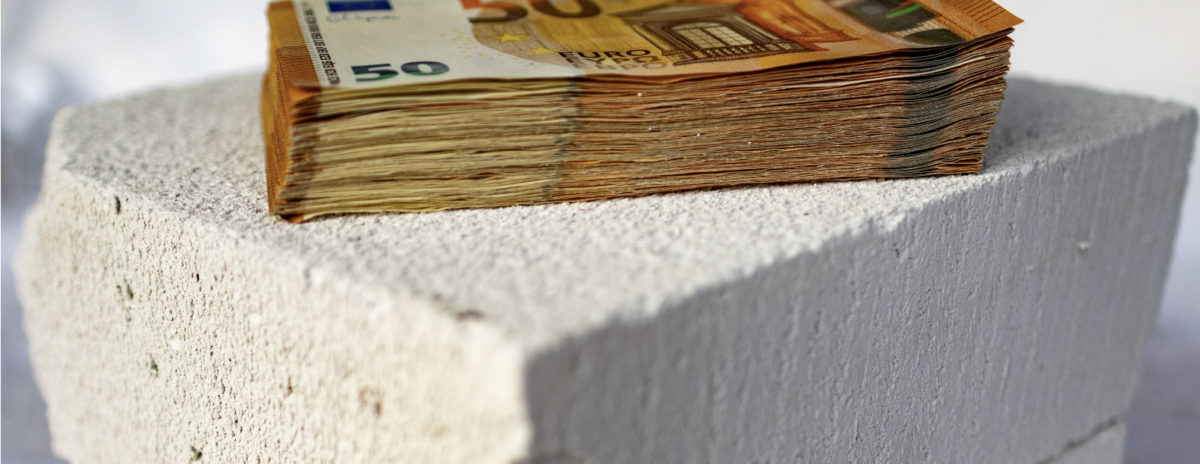
June 30, 2024
The Department for Business has recently published the latest statistics on construction prices in the UK. In this article, we’ll explore the commentary and statistics, such as construction material price indices, bricks and blocks production, and imports and exports.
We’ll look at this and more, without the jargon, to help you understand the direction the construction industry is heading in and to help you interpret what that could mean for you.
Material Price Indices – Inflation
The material price indices tracks the changes in prices of various construction materials over time, providing a strong indicator of inflation (or deflation) within the construction industry. It comprises pricing data across numerous categories:
- Aggregates – e.g., gravel, sand, and bitumen.
- Cement and concrete – e.g., precast concrete, ready-mixed concrete, and fibre cement.
- Clay products – e.g., bricks, ceramic sanitaryware, and tiles.
- Metal products – e.g., central heating boilers, fabricated steel, and screws.
- Plastic products – e.g., pipes, windows, and floor coverings.
- Timber – e.g., plywood, planed wood, and particle board.
- Other building materials – e.g., plasterboard, paint, and insulation.
Here’s how building material prices have been affected by inflation over the last decade:
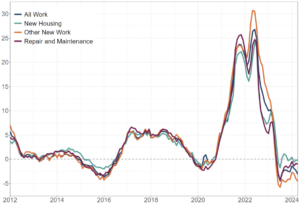
No surprises that the last few years have seen volatile inflation. The peak in 2021/22 occurred during the Covid-19 pandemic when there was a sharp rise in demand and supply shortages.
Important! The above graph depicts inflation year on year, not actual price changes. For instance, post-pandemic, the inflation rate slowed, but prices actually continued to rise.
Prices for “All Work” are now in a state of deflation, and have decreased a further 3.1% in April 2024 compared to April 2023, but now seem to have plateaued. Prices for “New Housing” decreased a negligible 0.2% year on year.
Biggest Movers In 12 Months (April 23 – April 24)
As far as actual construction material prices are concerned, here are the biggest movers in a 12-month period from April 23 to April 24:
| Construction materials | % change |
| Pipes and fittings | 19.3 |
| Metal doors and windows | 17.7 |
| Gravel, sand, clays, and kaolin – excl. aggregate levy | 11.3 |
| Gravel, sand, clays, and kaolin – incl. aggregate levy | -12.8 |
| Concrete reinforcing bars (steel) | -18.0 |
| Fabricated structural steel | -22.7 |
Production of Bricks, Blocks, and Concrete
The production of bricks, blocks, and concrete is perhaps the most significant indicator of the demand for construction projects; these figures provide a tangible measure of construction activity in the industry.
| Seasonally adjusted deliveries of bricks | Seasonally adjusted deliveries of concrete blocks |
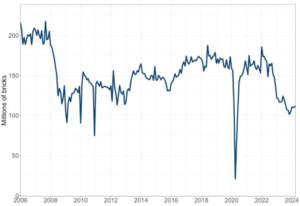 |
 |
| Seasonally adjusted sales of ready-mixed concrete | Seasonally adjusted sales of sand and gravel |
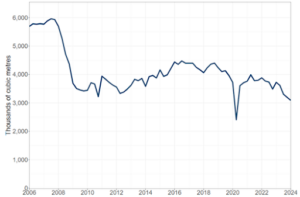 |
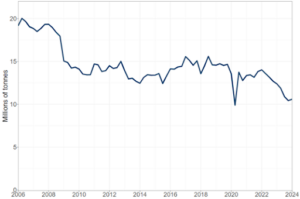 |
In all four charts, the trend is broadly the same. Sales (in volume) and deliveries of these building components have reached their lowest point in almost two decades, with the exception of the sharp decline at the outset of the pandemic (in 2020) due to lockdown measures. The last two years are responsible for a further 20–30% decline in output.
What does a decrease in demand mean for prices? If we drill down into the data, we can see that prices for these commodities are actually moving upward:
| Index | 2019 | 2020 | 2021 | 2022 | 2023 |
| Gravel, sand, clays and kaolin | 116.1 | 119.3 | 126.4 | 152.4 | 157.4 |
| Precast concrete: blocks, bricks, tiles and flagstones | 114.3 | 115.8 | 119 | 145.2 | 161.4 |
| Ready-mixed concrete | 103.5 | 101.2 | 107.2 | 126.5 | 147.2 |
| All bricks | [c] | [c] | [c] | [c] | [c] |
[c] represents confidential data.
These commodities are less affected by a reduction in demand because they are necessities, that is, without them, most construction jobs cannot be completed.
Imports and Exports
Where are building merchants and suppliers sourcing their products? There is an increasing trend towards importing building materials and components, especially since Brexit, while UK exports to other countries have been stagnant over the last decade.

- Most of the exports are to Ireland (£1.55bn), USA (£1.01bn), Germany (£0.75bn), the Netherlands (£0.65bn), and France (£0.55bn).
- Most of the imports are from China (£4.53bn), Germany (£2.13bn), Italy (£1.31bn), Spain (£1.25bn), and Turkey (£1.06bn).
|
Top 5 exports |
£(million) |
Top 5 imports |
£(million) |
| Electrical wires | 1,023 | Electrical wires | 2,756 |
| Paints and varnishes | 862 | Lamps and fittings | 1,090 |
| Lamps and fittings | 422 | Sawn wood (> 6mm) | 1,024 |
| Air-con equipment | 419 | Air-con equipment | 994 |
| Linoleum flooring | 360 | Ironmongery | 915 |
The annual trade deficit is widening because foreign suppliers can provide commodities much cheaper than UK suppliers. Almost as many building materials are now sourced from China as from Germany, Italy, and Spain combined.
What About Construction Output?
The Bank of England published its most recent update to the Agents’ Summary of Business Conditions in March. While no specific figures were reported, the report suggests that:
- Construction output volumes continue to fall
- House building has fallen markedly over the last year
- Commercial development continues to slow
- Housing associations continue to reduce new builds.
Some figures published by the Office for National Statistics (ONS) support this, suggesting that quarterly construction output saw a decrease of 0.9% in Quarter 1 (Jan to Mar) 2024 compared with Quarter 4 (Oct to Dec) 2023.
As for the overall housing market, the sentiment is slightly more positive among estate agents and economists:
- House prices appear to have bottomed out and are now expected to stay flat or grow modestly over the next few months.
- There are early signs of an improvement in demand, due to more supportive mortgage rates.
In terms of commercial real estate, development is broadly flat year on year and remains very weak, by historical standards. Developers cite the interest rate environment as the reason for this.
What About Construction Wages?
According to Statista, in March 2024, the average weekly wage of construction workers in the UK reached £739, which has been fairly flat for the last four years.
The chart below shows the average weekly earnings in the construction sector in the UK from June 2000 to March 2024.

This rise in wages is symptomatic of the shortage of labour in the construction industry, with vacancies reaching a peak of over 45,000 towards the end of 2023, the highest amount ever recorded.
Summary Of UK Construction Costs
Construction material prices are deflating, but this is likely a temporary adjustment following successive months, if not years, of price increases. In theory, prices dropping means it’s slightly easier for construction firms to lower their costs and pass on the savings to homeowners and developers.
However, the reality is that the current rate of deflation is unlikely to stimulate any real demand in the short term. Only a period of sustained deflation would present an opportunity for a significant shift in consumer behaviour and an increase in output.
Frequently Asked Questions About UK Construction Costs
Here are some frequently asked questions about the building costs in the UK.
How much does it cost to build a 3-bed house in the UK?
Based on the houses we covered in this article, you can expect a 3-bedroom house with a gross internal floor area of 110 square metres to cost around £279,597, or £2,541 per square metre (including labour and building materials). These costs vary by region.
How much does it cost to build an extension in the UK?
Based on the types of extension we covered in this article, you can expect a single-storey rear extension (gross external area of 30 square metres) to cost around £78,186 and a double-storey rear extension (with a gross external area of 60 square metres) to cost around £136,525. These costs vary by region.
How much does it cost to build a bungalow in the UK?
Based on the bungalows we covered in this article, you can expect building a two-bed bungalow (90m2) to cost £174,257, a three-bed bungalow (100m2) to cost £188,284, and a three-bed bungalow with garage and driveway (125m2) to cost £198,801. These costs vary by region.
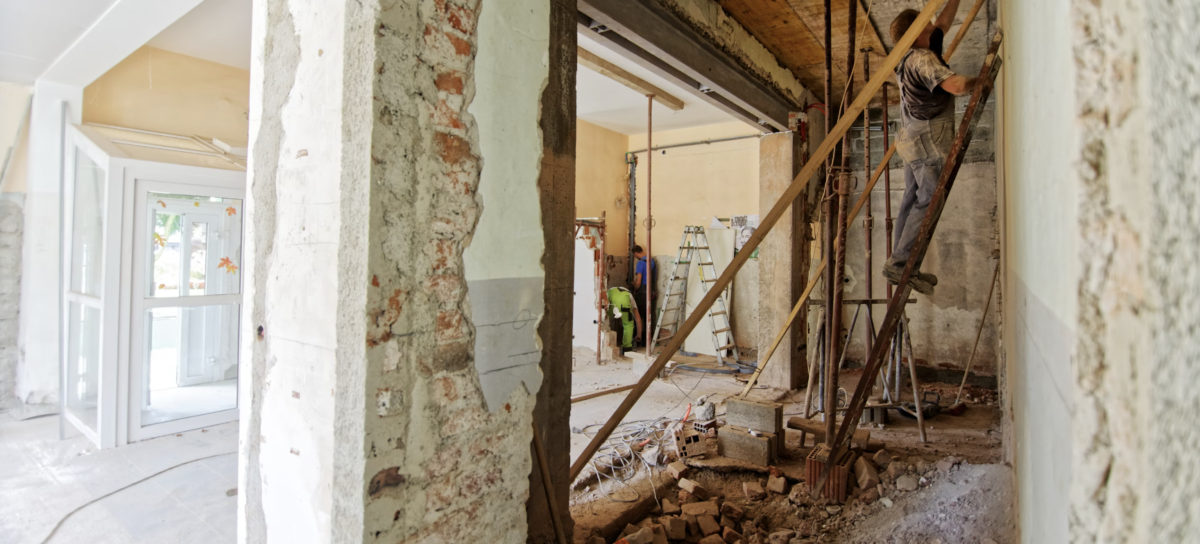
June 30, 2024
When calculating the costs for a home renovation, it’s easy to drown in a sea of variables such as what materials to include and exclude, what specifications to choose, and regional price variations. So, we’ve done the analysis for you.
In this 2024 guide, we provide several comprehensive cost breakdowns. We compare three different types of specifications (basic, standard, and high), to accommodate a range of budgets, and we also break the cost down per square metre.
Renovating A 3-Bedroom House
Before we look at the numbers, here are some things we’ve factored into the cost of renovating a 3-bedroom house:
- The total floor area of the average house in the UK is 94m2. All our calculations are based on a house of this size comprising three bedrooms, one bathroom, one kitchen, one WC, one living room, a landing, and an entrance hall.
- All appliances are included in the price, such as a built-in dishwasher, fridge, freezer, washing machine, extractor fan, hob, and oven. The only exclusion is a central heating boiler (radiators are included).
- A renovation (or house refurbishment) is not to be confused with a remodel. A renovation focuses exclusively on replacing the finishings and fittings in their existing locations and does not involve changing the layout of a structure.
In terms of build specification, our BuildPartner pricing tool gives you three options (which can be revised by item at a later point):
- Basic spec is a basic finish; e.g. Leyland, Everest, Wickes.
- Standard spec is a standard finish; e.g. Dulux, Hamilton, Slim Line.
- Premium spec is a high-spec finish; e.g. Farrow & Ball, Fine Line, Siemens.
For each specification, we’ve provided a range of prices to reflect the varying types of contractors:
- Low benchmark – smaller companies are generally lower cost but less specialised and with low project management function; good for low/mid-spec projects and tight budgets.
- Mid benchmark – medium-sized companies offer a balanced mix of cost-effectiveness and specialisation; good for mid-range projects for effective execution within moderate budgets.
- High benchmark – larger companies generally have a higher cost base but can handle a wide variety of specialist tasks; good for mid/high-spec projects and project management.
Cost Of A Basic-Spec Renovation
Here’s a table showing the average building costs of renovating a 3-bed house for a basic-spec project in the UK:
| 3-Bedroom House Refurb (Basic Spec) | Total Average Build Cost | Average Cost Per Sq Metre | ||||
| Low-Benchmark Contractor | Mid-Benchmark Contractor |
High Benchmark Contractor |
Low-Benchmark Contractor |
Mid-Benchmark Contractor |
High-Benchmark Contractor |
|
| East Anglia | £ 41,301 | £ 45,056 | £ 48,810 | £439 | £479 | £519 |
| London | £ 50,110 | £ 56,586 | £ 62,138 | £533 | £602 | £661 |
| Midlands | £ 39,937 | £ 43,568 | £ 47,198 | £425 | £463 | £502 |
| North England | £ 39,502 | £ 43,093 | £ 46,684 | £420 | £458 | £497 |
| N. Ireland | £ 38,357 | £ 40,686 | £ 44,076 | £397 | £433 | £469 |
| Scotland | £ 39,418 | £ 43,001 | £ 46,585 | £419 | £457 | £496 |
| South East | £ 46,102 | £ 51,550 | £ 57,194 | £533 | £596 | £654 |
| South West | £ 40,666 | £ 46,182 | £ 50,688 | £439 | £491 | £539 |
| Wales | £ 40,030 | £ 44,761 | £ 48,335 | £426 | £476 | £514 |
| Average | £ 41,714 | £ 46,054 | £ 50,190 | £448 | £495 | £539 |
All costs exclude VAT.
Here’s what the data shows for the cost of renovating a 3-bed house to a basic spec:
- It costs 26% more to renovate a 3-bed house in London than in other regions.
- The minimum cost is £38,357 and the maximum cost is £62,138.
- The total average cost is £45,986, or £494 per square metre.
Renovation Cost Breakdown By Project Stage – London
Here’s an example of the associated costs for the different stages of a renovation for a basic-spec project – when using a mid-benchmark contractor in London:
| Total | £56,586 | 100.0% |
| Preliminaries | £51 | 0.1% |
| Demolitions | £4,043 | 7.1% |
| Heating and cooling | £2,772 | 4.9% |
| Plumbed appliances | £3,347 | 5.9% |
| Wired appliances | £7,513 | 13.3% |
| Wall preparation and finishes | £2,477 | 4.4% |
| Floor preparation and finishes | £9,948 | 17.6% |
| Units, worktops and kitchen appliances | £10,828 | 19.1% |
| Decoration | £15,092 | 26.7% |
| Fixtures and fittings | £515 | 0.9% |
Renovation Cost Breakdown By Room – London
Here’s a breakdown of the associated costs by room for a basic-spec renovation project – when using a mid-benchmark contractor in London:
| Total | £56,586 | 100% |
| Bathroom | £8,644 | 15.3% |
| Bedroom 1 | £5,744 | 10.2% |
| Bedroom 2 | £5,744 | 10.2% |
| Bedroom 3 | £5,744 | 10.2% |
| Entrance Hall | £2,807 | 5.0% |
| Kitchen | £20,933 | 37.0% |
| Landing/stairs | £2,539.03 | 4.5% |
| WC | £4,432.45 | 7.8% |
Remember, appliances are included in the costs, which is why the kitchen accounts for a disproportionate amount of the total expense.
Cost Of A Standard-Spec Renovation
Here’s a table showing the average building costs of renovating a 3-bed house for a standard-spec project in the UK:
| 3-Bedroom House Refurb (Standard Spec) | Total Average Build Cost | Average Cost Per Sq Metre | ||||
| Low-Benchmark Contractor |
Mid-Benchmark Contractor | High-Benchmark Contractor | Low-Benchmark Contractor | Mid-Benchmark Contractor | High-Benchmark Contractor | |
| East Anglia | £52,842 | £57,646 | £62,450 | £562 | £613 | £664 |
| London | £61,652 | £69,492 | £76,302 | £656 | £739 | £812 |
| Midlands | £51,478 | £56,158 | £60,837 | £548 | £597 | £647 |
| North England | £51,043 | £55,684 | £60,324 | £543 | £592 | £642 |
| N. Ireland | £49,898 | £53,276 | £57,716 | £520 | £567 | £614 |
| Scotland | £50,959 | £55,591 | £60,224 | £542 | £591 | £641 |
| South East | £56,719 | £63,423 | £69,610 | £656 | £733 | £805 |
| South West | £52,207 | £59,087 | £64,852 | £562 | £629 | £690 |
| Wales | £51,571 | £57,666 | £61,974 | £549 | £613 | £659 |
| Average | £53,152 | £58,669 | £63,810 | £571 | £631 | £686 |
All costs exclude VAT.
Here’s what the data shows for the cost of renovating a 3-bed house to a standard spec:
- The minimum cost is £49,898 and the maximum cost is £76,302.
- The total average cost is £58,544, or £629 per square metre.
Renovation Cost Breakdown By Project Stage – London
Here’s an example of the associated costs for the different stages of a renovation for a standard-spec project – when using a mid-benchmark contractor in London:
| Total | £69,492 | 100.0% |
| Preliminaries | £51 | 0.1% |
| Demolitions | £4,043 | 5.8% |
| Heating and cooling | £3,324 | 4.8% |
| Plumbed appliances | £4,818 | 6.9% |
| Wired appliances | £8,242 | 11.9% |
| Wall preparation and finishes | £3,111 | 4.5% |
| Floor preparation and finishes | £13,147 | 18.9% |
| Units, worktops and kitchen appliances | £16,384 | 23.6% |
| Decoration | £15,488 | 22.3% |
| Fixtures and fittings | £884 | 1.3% |
Renovation Cost Breakdown By Room – London
Here’s a breakdown of the associated costs by room for a standard-spec renovation project – when using a mid-benchmark contractor in London:
| Total | £69,492 | 100% |
| Bathroom | £11,053 | 15.9% |
| Bedroom 1 | £6,479 | 9.3% |
| Bedroom 2 | £6,479 | 9.3% |
| Bedroom 3 | £6,479 | 9.3% |
| Entrance Hall | £3,029 | 4.4% |
| Kitchen | £27,957 | 40.2% |
| Landing/stairs | £2,775.49 | 4.0% |
| WC | £5,238.83 | 7.5% |
Cost Of A Premium-Spec Renovation
Here’s a table showing the average building costs of renovating a 3-bed house for a premium-spec project in the UK:
| 3-Bedroom House Refurb (Premium Spec) | Total Average Build Cost | Average Cost Per Sq Metre | ||||
| Low-Benchmark Contractor | Mid-Benchmark Contractor | High-Benchmark Contractor | Low-Benchmark Contractor | Mid-Benchmark Contractor | High-Benchmark Contractor | |
| East Anglia | £74,642 | £81,428 | £88,213 | £794 | £866 | £938 |
| London | £83,452 | £93,868 | £103,057 | £888 | £999 | £1,096 |
| Midlands | £73,278 | £79,940 | £86,601 | £780 | £850 | £921 |
| North England | £72,843 | £79,466 | £86,088 | £775 | £845 | £916 |
| N. Ireland | £71,386 | £77,876 | £84,366 | £759 | £828 | £898 |
| Scotland | £72,759 | £79,373 | £85,988 | £774 | £844 | £915 |
| South East | £76,775 | £85,849 | £95,248 | £817 | £913 | £1,013 |
| South West | £74,007 | £83,463 | £91,606 | £787 | £888 | £975 |
| Wales | £73,371 | £82,042 | £87,738 | £781 | £873 | £933 |
| Average | £74,724 | £82,590 | £89,878 | £795 | £879 | £956 |
All costs exclude VAT.
Here’s what the data shows for the cost of renovating a house to a premium spec:
- The minimum cost is £71,386 and the maximum cost is £103,057.
- The total average cost is £82,397, or £877 per square metre.
Renovation Cost Breakdown By Project Stage – London
Here’s an example of the associated costs for the different stages of a renovation for a premium-spec project – when using a mid-benchmark contractor in London:
| Total | £93,868 | 100.0% |
| Preliminaries | £51 | 0.1% |
| Demolitions | £4,043 | 4.3% |
| Heating and cooling | £4,641 | 4.9% |
| Plumbed appliances | £6,886 | 7.3% |
| Wired appliances | £9,779 | 10.4% |
| Wall preparation and finishes | £5,221 | 5.6% |
| Floor preparation and finishes | £19,864 | 21.2% |
| Units, worktops and kitchen appliances | £24,736 | 26.4% |
| Decoration | £17,012 | 18.1% |
| Fixtures and fittings | £1,634 | 1.7% |
Renovation Cost Breakdown By Room – London
Here’s a breakdown of the associated costs by room for a premium-spec renovation project – when using a mid-benchmark contractor in London:
| Total | £93,868 | 100% |
| Bathroom | £16,303 | 17% |
| Bedroom 1 | £7,702 | 8% |
| Bedroom 2 | £7,702 | 8% |
| Bedroom 3 | £7,702 | 8% |
| Entrance Hall | £3,715 | 4% |
| Kitchen | £40,546 | 43% |
| Landing/stairs | £3,246.50 | 3% |
| WC | £6,950.75 | 7% |
Summary Of The Average Cost To Renovate A UK Home
So, how much does a house renovation cost in the UK? Based on the three different specifications covered in this article (basic, standard, and high), you can expect that renovating a 3-bed home to cost on average (when using a mid-benchmark contractor):
- Basic spec – £46,054, or £495 per sq metre.
- Standard spec – £58,669, or £631 per sq metre.
- Premium spec – £82,590, or £879 per sq metre.
Depending on specification, for a 3-bedroom house, the cost of the renovation work ranges between £38,357 and £103,057. Please remember that these costs do not include VAT and there may be other additional costs, such as obtaining planning permission (in certain exceptions), structural surveys, unexpected repairs, and custom finishes.
Frequently Asked Questions About Home Renovations
Here are a few questions which will shed some light on UK home renovations.
How long does a home renovation take?
Based on a 3-bedroom property comprising the rooms listed above, a renovation would take approximately nine to 12 weeks when two tradespeople are carrying out the scheduled work (demolitions, heating and cooling, wall preparation, floor preparation, plumbed and wired appliances, kitchen units, decoration, and fixtures and fittings).
What’s the difference between remodelling and renovating a house?
The terms “remodelling” and “renovating” are often used interchangeably, but they refer to different projects. Renovating focuses on updating or restoring the house without altering its structure, such as installing new kitchens or bathrooms, replacing flooring or windows, and refreshing the home’s current condition.
Remodelling involves changing the structure of a house, such as altering the layout or adding new rooms, like creating open-plan spaces, adding bathrooms, and converting basements to transform the house’s function and appearance.
Do I need planning permission for my renovation?
Planning permission is not needed for internal renovations that don’t alter the structure or layout of a property. Exceptions include renovating a listed property or if you live within a conservation area, especially for alterations that affect the external appearance. Ultimately, it’s up to the local council to decide if the “character of the building” will be affected.
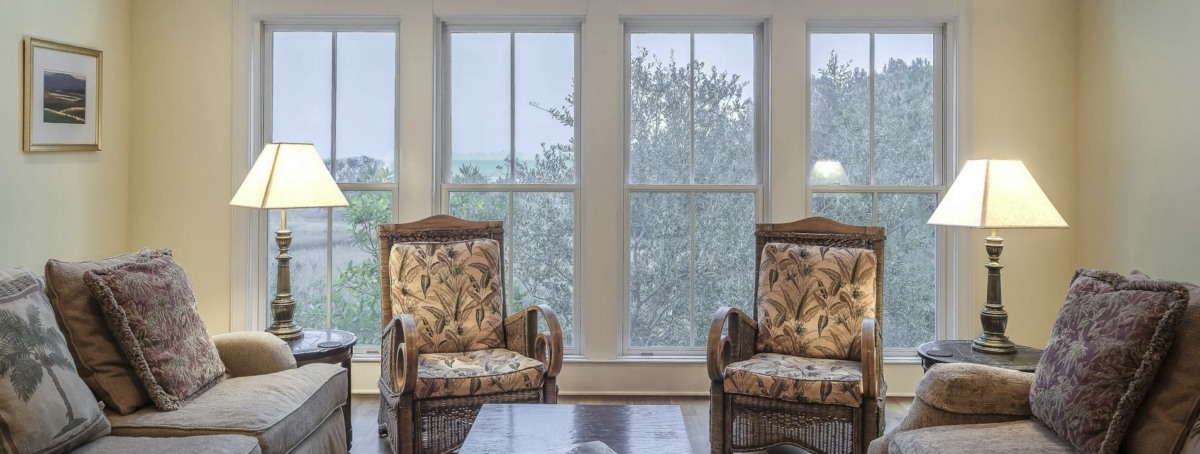
How do you balance functionality and aesthetics when creating a lighting plan? Lighting sometimes falls by the wayside during the planning stages and is often overlooked for more grandiose aspects of our designs. But when a project is complete, the impact of good or bad lighting can be immediately felt—at which point, it’s too late to rectify.
Rebecca Weir, creative director at Light IQ, says ‘Architectural lighting should be discussed at the outset of a project.’ Doing so helps avoid common mistakes made with new-build projects, where lighting is too often an afterthought.
1. Aesthetic Goals
Lighting isn’t simply a means to eliminate darkness. Identifying specific goals for each lighting element helps us decide what kinds of light to choose, as well as the colour, intensity, and shape.
When someone steps into a room, how do you want them to feel? The intensity and colour temperature of the light creates a certain ambiance. Consider these two contrasting goals and their respective solutions:
- Goal: cosy, intimate dining room – Solution: low light dimmers.
- Goal: a study room that inspires productivity – Solution: bright, cool lighting.
Get it the wrong way round and you may well induce a person to sleep in their office or study.
Ambience is just one goal you might want to consider; you can also manipulate lighting to:
- Accentuate specific elements – Lighting can be strategically placed to highlight artwork on walls or sculptures.
- Make a space feel bigger – Recessed lighting in the ceiling can create an illusion of greater height, making the room feel larger and more expansive.
- Spark conversation and impress – Installing a statement piece gets people’s attention the moment they walk in.
The challenge lies in finding lighting that meets multiple goals. It’s not enough to simply have a contemporary light fitting if the lighting is inadequate or casts unwanted shadows.
You need lighting where form follows function.
2. Natural Light Considerations
Artificial lights are one part of the equation. Natural light is another aspect that’s often overlooked, and it has a significant effect on people’s psychological state and how they behave.
Living in the UK, especially during those short, dark winter days, your goal may be to invite as much natural light as possible. In which case, be mindful that north-facing rooms receive less direct sunlight during the day compared to rooms facing other directions.
In another room, however—say, a study—too much light may cause screen glare. Ever heard of smart glass? It can change its transparency to control glare, but it also contributes to heat gain, improving energy efficiency.
One of the most convenient options for letting in natural light that’s favoured by developers is a skylight, and they come in many forms:
- Pitched skylights – can be opened and closed
- Fixed skylights – stationary and cannot be opened
- Ventilating skylights – can be opened and closed
- Pyramid skylights – often used in commercial buildings or atriums
There’s nothing quite like standing beneath a skylight during a storm.
Be mindful that too many windows can cause a greenhouse effect, with buildings overheating in the sun and rapidly losing heat when the temperature drops.

3. Energy Efficiency and Sustainability
The energy efficiency of every product we use is becoming increasingly important from a sustainability perspective. Not only that, buildings that are more energy-efficient can attract higher sale values, both in private and commercial sectors.
Research led by the real estate consultant JLL examined 592 offices in Central London and found that Capital values were on average 20.6% higher as a result of BREEAM certification.
So, what can we do to lessen the energy consumption of a property through our lighting plan?
- Install dimmers – adjusting the brightness levels avoids wasting energy for excessive light and gives greater control of the setting of the ambiance.
- Select the right lamps – LED light bulbs are currently the most efficient option, particularly chip-on-board (COB) which offers higher lumen output and better energy efficiency.
- Avoid certain light fixtures – does a property really need countless spotlights, accent lighting in unused areas, and excessive landscape lighting?
- Use motion sensors and timers – automatically control lighting, ensuring lights are only active when necessary, thus reducing energy waste.
- Implement automation – manage lighting schedules and preferences to optimise energy usage and enhance overall efficiency.
It’s worth noting that Wi-Fi-operated automations, colloquially known as ‘vampire appliances’, still consume fractions of power when on standby or turned off.
4. Ambient, Task, & Accent Lighting
Lighting layering refers to the technique of using multiple types of lights and fixtures within one space. There are essentially three layers of lighting:
- Ambient lighting – natural light, ceiling fixtures, etc.
- Task lighting – pendant lighting, kitchen worktop lighting, floor lamps, etc.
- Accent lighting – wall sconces, cove lighting, step lighting, etc.
While layering requires more complex planning and installation, there are many benefits for the occupants, namely improving comfort by avoiding unnecessary brightness when not needed.
For instance, in a museum, ambient lighting from skylights and ceiling fixtures are the main ambient light sources, while task lighting directs light towards specific exhibits, and accent lighting highlights individual artworks.
At home, a similar approach could be applied in a study where windows and ceiling lights provide ambient lighting, desk lamps offer task lighting for work surfaces, and LED strips or backlights illuminate the edge of the desk for added visibility.

5. Up-Lighting, Down-Lighting, & Cross-Lighting
The position of lighting helps create certain atmospheric effects. Have you considered any of the following when designing your lighting system?
- Up-lighting involves positioning light fixtures at ground level to illuminate architectural features from below, such as columns, trees, or facades.
- Down-lighting or overhead lighting involves mounting fixtures on high surfaces to highlight specific areas, such as seating areas or pathways.
- Cross-lighting involves placing fixtures at opposing angles to illuminate to accentuate an object’s profile and texture.
Before you commit, it’s worth noting the following drawbacks of each:
- Uplights don’t evenly illuminate large areas or tall spaces, leading to uneven lighting distribution and potential shadows in certain areas.
- Downlights positioned at eye level or with insufficient shielding cause glare, which some may find too dazzling.
- Cross-lighting produces pronounced shadows, disrupting the overall appeal of adjacent walls and the coherence of the environment.
These types of lighting aren’t generally necessities, but they more distinctly convey the character and mood of a particular space.
6. Wall Washing
Those who obsess about uniformity will appreciate the washing technique—which is where a uniform layer of light is projected over a surface, typically a wall or ceiling, to create an even glow.
Wall washing the axes of a room and its functional areas clear, and a bright background is pleasant to the eye (which can even prevent fatigue).
Certain lights, like light bars with adjustable spotlights, are notorious for creating bright spots and shadowed areas.
The solution to achieving uniformity lies in making two choices:
- Light fitting type – choose something unshaded or unobstructed; recessed spotlights tend to create an even glow; even lights with transparent decorations refract light and cast shadows.
- Strategic placement of lights – consider the proximity of light fittings and the walls as well as the angle of the light fixture’s lamps.
Wall washing, when done correctly, affects our perception of a room’s size.
Creating a Lighting Scheme for Your Project
The interplay of light and shadow goes beyond the simple hitting of a switch; it’s an art form that shapes our perception of space and influences how we interact with it.
Perhaps the biggest pitfall is when we design a lighting plan that’s homogenous throughout a property. Each room—and even space—has its own lighting needs. When creating a lighting scheme, it’s helpful to consider each room in isolation before firming up a specification.
Frequently Asked Questions About Lighting Plans
Here are some frequently asked questions about lighting plans.
What is a BREEAM-certified building?
BREEAM is the world’s leading sustainability assessment method that scrutinises the acquisition, design, construction, and operation of a development. Central to its evaluation are sustainability objectives spanning diverse categories, including energy, land use, ecology, and water.
What’s the difference between ambient, task, and accent lighting?
Ambient lighting acts as the main light source in a space, task lighting offers targeted illumination for particular activities (like a bright desk lamp when writing), and accent lighting draws attention to specific elements within a room (such as a spotlight for an ornamental vase)
What is architectural lighting design?
Architectural lighting is the intersection of art (architecture) and technology (lighting). It serves to emphasise a building’s aesthetic, history, and purpose. Physics, engineering, and the psychological effects of light also influence architectural lighting design.
How Much Does It Cost To Build A Bungalow In The UK?
- Post author By ken
- Post date May 21, 2024
- No Comments on How Much Does It Cost To Build A Bungalow In The UK?
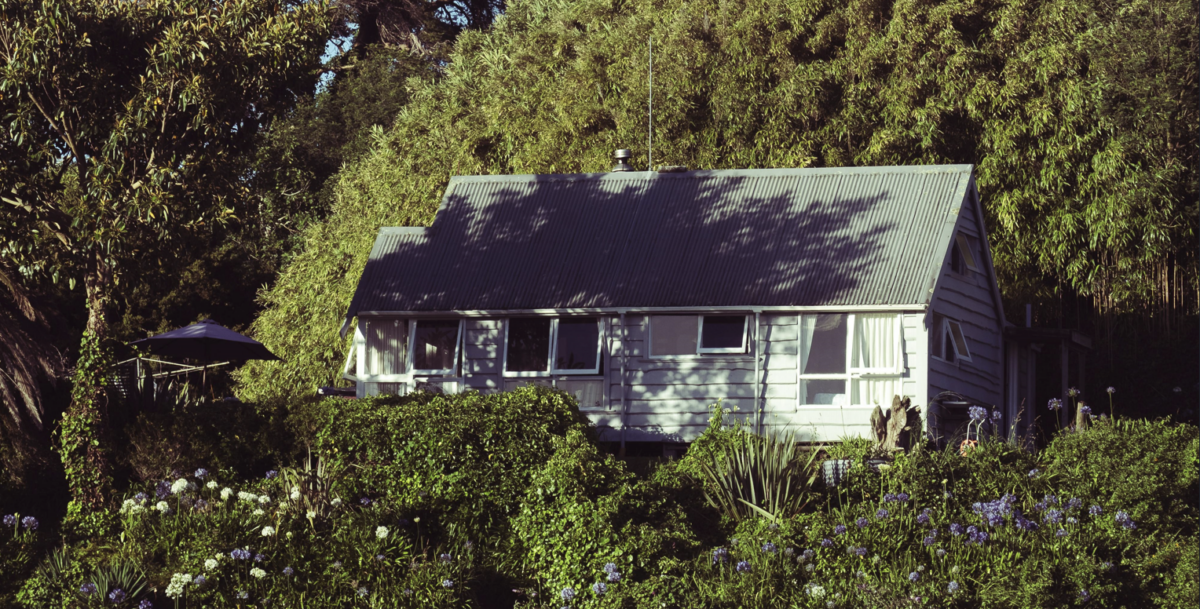
With an aging population in the UK, Bungalows are in high demand. The average price of a bungalow rose by 17% in 2023, compared with 13% for houses and 5% for flats. The rising demand (and prices) has many wondering what the total cost of building a bungalow is. Naturally, building costs vary by size, type, and complexity, so in this article, we’ll cover the cost of building a bungalow across various regions in the UK.To give you an accurate view, we’ll compare the cost of building three different types of bungalows:
- Two-bedroom bungalow (90m2)
- Three-bedroom bungalow (100m2)
- Three-bedroom bungalow with garage and driveway (125m2)
Let’s delve into the cost breakdown for each bungalow, as well as the average costs per sq metre, to ensure your project is accurately costed and to minimise overspend.
The Bungalow Bottleneck
With no stairs, bungalows are practical for people who have mobility issues, but there aren’t enough of them to go around. The National House Building Council (NHBC) says bungalows are “on the critically endangered list” after construction recently hit an 80-year low.
There are just 228 new bungalows registered to be built between July and September 2024. But the need to provide housing for those aged 65 and over has reached a critical point. Right now, there are over 10 million people currently aged 65 and over (18% of the population).
In the next 40 years, the number of people:
- Aged 65-79 is predicted to increase by 30% to over 10 million.
- Aged 80 and over is set to more than double to over 6 million.
Is now a good time to build a new bungalow? Demand is certainly not lacking, but developers find it challenging to make them financially viable due to limited space and lower profit margins compared to two-storey homes.
Let’s take a look at how much they cost.
Building A Bungalow Construction Cost Calculations
In our calculations, we applied a consistent methodology across nine regions: East Anglia, London, the Midlands, North England, Northern Ireland, Scotland, South East England, South West England, and Wales.
In terms of build specification, BuildPartner’s pricing tool gives you three broad options (which can be revised by item at a later point):
- Low spec is a basic finish; e.g. Leyland, Everest, Wickes.
- Mid spec is a standard finish; e.g. Dulux, Hamilton, Slim Line.
- High spec is a high-spec finish; e.g. Farrow & Ball, Fine Line, Siemens.
To keep our comparisons simple, we have chosen mid spec in all our cost estimations. We’ve also provided three different benchmarks to show the types of contractors. These are:
- Low benchmark – smaller companies are generally lower cost but less specialised and with low project management function; good for low/mid-spec projects and tight budgets.
- Mid benchmark – medium-sized companies offer a balanced mix of cost-effectiveness and specialisation; good for mid-range projects for effective execution within moderate budgets.
- High benchmark – larger companies generally have a higher cost base but can handle a wide variety of specialist tasks; good for mid/high-spec projects and project management.
Cost Of Building A Two-Bed Bungalow (90m2)
Below is a table showing the average cost of building a two-bedroom bungalow (90m2) in the UK, comprising the following rooms:
- Two bedrooms
- Open-plan kitchen-living-dining room
- Bathroom
- Cloakroom
- Pantry
| Two-bed bungalow (90m2) | Total Average Build Cost | Average Cost Per Sq Metre | ||||
| Low Benchmark | Mid Benchmark | High Benchmark | Low Benchmark | Mid Benchmark | High Benchmark | |
| East Anglia | £156,796 | £171,051 | £185,305 | £1,742 | £1,901 | £2,059 |
| London | £180,904 | £203,693 | £227,662 | £2,010 | £2,263 | £2,530 |
| Midlands | £153,565 | £167,526 | £181,486 | £1,706 | £1,861 | £2,017 |
| North England | £146,917 | £166,410 | £180,277 | £1,632 | £1,849 | £2,003 |
| N. Ireland | £149,446 | £160,273 | £173,630 | £1,632 | £1,781 | £1,929 |
| Scotland | £151,975 | £165,790 | £179,607 | £1,689 | £1,842 | £1,996 |
| South East | £166,677 | £186,375 | £206,781 | £2,013 | £2,251 | £2,471 |
| South West | £155,249 | £175,327 | £192,432 | £1,742 | £1,948 | £2,138 |
| Wales | £153,701 | £171,866 | £184,256 | £1,708 | £1,910 | £2,047 |
| Average | £157,248 | £174,257 | £190,159 | £1,764 | £1,956 | £2,132 |
All costs exclude VAT.
Here’s what the data shows for the cost of building a two-bedroom bungalow (90m2):
- It costs 20% more to build a two-bedroom bungalow in London than in other regions.
- The minimum cost is £146,917 and the maximum cost is £227,662.
- The total average cost is £173,888, or £1,951 per square metre.
Cost Of Building A Three-Bed Bungalow (100m2)
Below is a table showing the average cost of building a three-bedroom bungalow (100m2) in the UK, comprising the following rooms:
- Three bedrooms
- Open-plan kitchen-living-dining room
- Bathroom
- Cloakroom
- Pantry
- Separate WC
| Three-bed bungalow (100m2) | Total Average Build Cost | Average Cost Per Sq Metre | ||||
| Low Benchmark | Mid Benchmark | High Benchmark | Low Benchmark | Mid Benchmark | High Benchmark | |
| East Anglia | £167,968 | £183,238 | £198,507 | £1,680 | £1,832 | £1,985 |
| London | £193,862 | £218,334 | £244,445 | £1,939 | £2,183 | £2,444 |
| Midlands | £164,484 | £179,437 | £194,390 | £1,645 | £1,794 | £1,944 |
| North England | £157,344 | £178,247 | £193,101 | £1,573 | £1,782 | £1,931 |
| N. Ireland | £160,067 | £185,953 | £171,648 | £1,573 | £1,860 | £1,716 |
| Scotland | £162,789 | £177,588 | £192,387 | £1,628 | £1,776 | £1,924 |
| South East | £178,720 | £199,842 | £219,338 | £1,943 | £2,172 | £2,384 |
| South West | £166,305 | £187,819 | £206,143 | £1,680 | £1,878 | £2,061 |
| Wales | £164,642 | £184,099 | £197,382 | £1,646 | £1,841 | £1,974 |
| Average | £168,464 | £188,284 | £201,927 | £1,701 | £1,902 | £2,040 |
Here’s what the data shows for the cost of building a three-bedroom bungalow (100m2):
- The minimum cost is £157,344 and the maximum cost is £244,445.
- The total average cost is £186,225, or £1,881 per square metre.
Cost Of Building A Three-Bed Bungalow With Garage & Driveway (125m2)
Below is a table showing the average cost of building a three-bedroom bungalow (125m2) with a garage and driveway, comprising the following:
- Three bedrooms
- Open-plan kitchen-living-dining room
- Bathroom
- Cloakroom
- Pantry
- Separate WC
- Garage with a pitched roof
- Driveway
| Three-bed bungalow w. garage/driveway (125m2) | Total Average Build Cost | Average Cost Per Sq Metre | ||||
| Low Benchmark | Mid Benchmark | High Benchmark | Low Benchmark | Mid Benchmark | High Benchmark | |
| East Anglia | £178,546 | £194,777 | £211,009 | £1,428 | £1,558 | £1,688 |
| London | £205,980 | £231,885 | £259,317 | £1,648 | £1,855 | £2,075 |
| Midlands | £174,904 | £190,805 | £206,705 | £1,399 | £1,526 | £1,654 |
| North England | £167,406 | £189,541 | £205,336 | £1,339 | £1,516 | £1,643 |
| N. Ireland | £164,058 | £185,750 | £201,229 | £1,312 | £1,486 | £1,610 |
| Scotland | £173,022 | £188,751 | £204,481 | £1,384 | £1,510 | £1,636 |
| South East | £189,869 | £212,308 | £235,553 | £1,519 | £1,698 | £1,884 |
| South West | £176,804 | £199,646 | £219,124 | £1,414 | £1,597 | £1,753 |
| Wales | £175,062 | £195,751 | £209,832 | £1,400 | £1,566 | £1,679 |
| Average | £178,405 | £198,801 | £216,954 | £1,427 | £1,590 | £1,736 |
Here’s what the data shows for the cost of building a three-bedroom bungalow (125m2):
- The minimum cost is £164,058 and the maximum cost is £259,317.
- The total average cost is £198,054, or £1,584 per square metre.
How Much Does It Cost To Build A Bungalow In 2024?
So, how much does it cost to build a new bungalow in the UK? That depends largely on where you are building. Based on the three types of bungalows covered in this article, building a bungalow could cost on average (when using a mid-benchmark contractor):
- Two-bed bungalow (90m2) – £174,257, or £1,956 per square metre
- Three-bed bungalow (100m2) – £188,284, or £1,902 per square metre
- Three-bed bungalow w. garage/driveway (125m2) – £198,801, or £1,590 per square metre
Please remember all costs exclude VAT.
Other Build Costs To Factor In
Please note that these costs do not encompass utility fees like gas, water, and electricity, nor do they include design fees for NHBC, architects, civil engineers, structural engineers, or party wall agreements. Additionally, costs for anomalies such as ground obstructions, contaminated waste, or project-specific site requirements are excluded. There is no contingency included in these costs, which would typically add around 5% to the budget.
Frequently Asked Questions About Build Cost Of Bungalows
Here are some frequently asked questions about building a bungalow in the UK.
Can I build a bungalow in my back garden?
You can build a bungalow in your back garden, subject to obtaining planning permission from your local authority. There are building regulations and guidelines you’ll need to adhere to, such as those concerning the size, height, and distance from property boundaries.
Can you build up on a bungalow?
It’s possible to build upward on a bungalow by adding additional floors on top of the existing single-storey structure. Although the foundations are already in place, any plan to build upward would require an evaluation of their capacity to support additional floors.
As always, you would need to obtain planning permission from your local authority before proceeding, as there are regulations and guidelines governing building height, structural integrity, and aesthetics.
Is there a shortage of bungalows?
Construction of new-build bungalows has hit an 80-year low, and there is a huge demand for accessible living due to the ageing population. However, building upwards instead of on the ground floor allows a builder to maximise land usage (particularly where land is expensive) and create more dwellings within the same footprint.
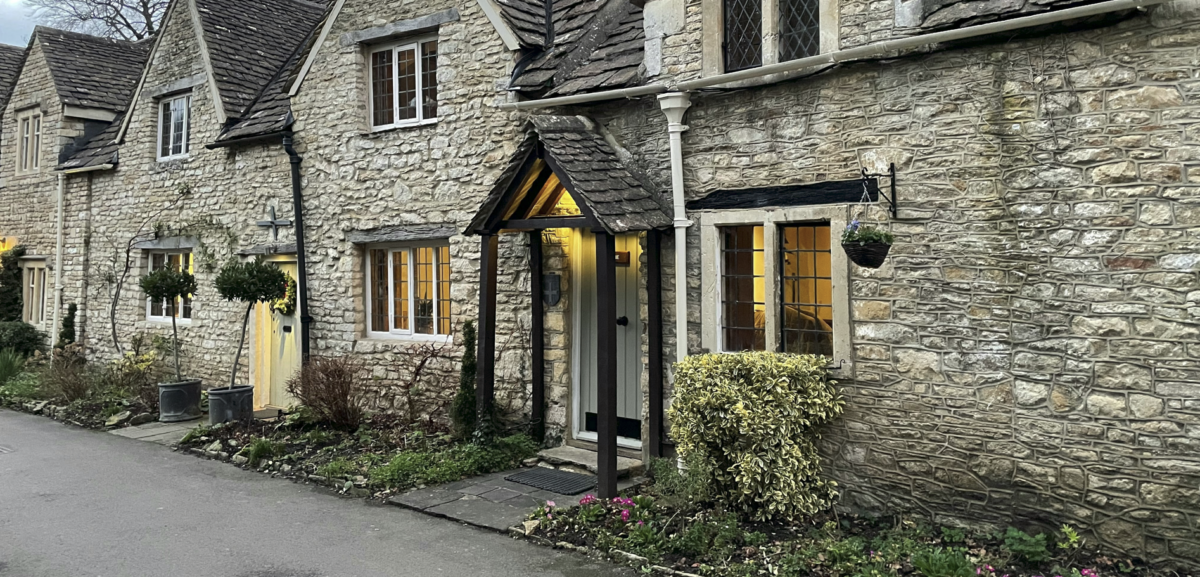
Estimating the cost of building a porch is challenging when the economy is wrestling with inflation. Material costs and labour have risen substantially. We’ll bring you up to speed on just how much to ensure your project is accurately costed and to minimise overspend.r Naturally, building costs vary by size, type, and complexity, so in this article, we’ll cover the cost of building a porch across various regions in the UK.
To give you an accurate view of costs, we’ll compare four different types of porches:
- Brick porch – constructed with bricks.
- Rendered porch – built with blocks and a rendered finish.
- Timber porch (enclosed) – made primarily from wood.
- Open porch – without enclosed walls, and offering an external shelter.
Let’s explore the cost breakdown for each type of porch, to help you make an informed decision about on which is best for your construction project.
Building A Porch Construction Cost Calculations
In our calculations, we applied a consistent methodology across different regions. The cost comparisons are based on a gross external floor area (GEFA) of 3m². You can build a porch as large as this without submitting a planning permission application.
The only exception is the open porch. Our calculation for this is based on a GEFA of 2m2, which more than suffices.
In terms of build specification BuildPartner pricing tool gives you three broad options (which can be revised by item at a later point):
- Low spec is a basic finish; e.g. Leyland, Everest, Wickes.
- Mid spec is a standard finish; e.g. Dulux, Hamilton, Slim Line.
- High spec is a high-spec finish; e.g. Farrow & Ball, Fine Line, Siemens.
To keep this comparison simple, we have chosen mid spec in all our cost estimations. In addition to this, we have also provided three different benchmarks to show the range you can expect amongst different contractors. These are:
- Low benchmark – smaller companies are generally lower cost but less specialised and with low project management function; good for low/mid-spec projects and tight budgets.
- Mid benchmark – medium-sized companies offer a balanced mix of cost-effectiveness and specialisation; good for mid-range projects for effective execution within moderate budgets.
- High benchmark – larger companies generally have a higher cost base but can handle a wide variety of specialist tasks; good for mid/high-spec projects and project management.
Cost Of Building A Brick Porch
Here’s a table showing the average cost of building a 3m2 brick porch in the UK:
| Brick Porch | Total Average Build Cost | Average Cost Per Sq Metre | ||||
| Low Benchmark | Mid Benchmark | High Benchmark | Low Benchmark | Mid Benchmark | High Benchmark | |
| East Anglia | £6,923 | £7,552 | £8,181 | £2,308 | £2,517 | £2,727 |
| London | £8,100 | £9,057 | £10,094 | £2,700 | £3,019 | £3,365 |
| Midlands | £6,773 | £7,389 | £8,004 | £2,258 | £2,463 | £2,668 |
| North England | £6,454 | £7,327 | £7,938 | £2,151 | £2,442 | £2,646 |
| Northern Ireland | £6,565 | £7,627 | £7,040 | £2,151 | £2,542 | £2,347 |
| Scotland | £6,676 | £7,283 | £7,890 | £2,225 | £2,428 | £2,630 |
| South East | £7,452 | £8,333 | £9,245 | £2,700 | £3,019 | £3,314 |
| South West | £6,850 | £7,741 | £8,496 | £2,308 | £2,580 | £2,832 |
| Wales | £6,778 | £7,579 | £8,133 | £2,259 | £2,526 | £2,711 |
| Average | £6,952 | £7,765 | £8,336 | £2,340 | £2,615 | £2,804 |
All costs exclude VAT.
Here’s what the data shows for the cost of building a brick porch:
- It costs 21% more to build a porch in London than in other regions.
- The minimum cost is £6,454 and the maximum cost is £10,094.
- The total average cost is £7,684, or £2,587 per square metre.
Cost Of Building A Rendered Porch
Here’s a table showing the average cost of building a 3m2 rendered porch in the UK:
| Rendered Porch | Total Average Build Cost | Average Cost Per Sq Metre | ||||
| Low Benchmark | Mid Benchmark | High Benchmark | Low Benchmark | Mid Benchmark | High Benchmark | |
| East Anglia | £6,387 | £6,968 | £7,549 | £2,129 | £2,323 | £2,516 |
| London | £7,405 | £8,281 | £9,241 | £2,468 | £2,760 | £3,080 |
| Midlands | £6,257 | £6,826 | £7,395 | £2,086 | £2,275 | £2,465 |
| North England | £5,979 | £6,774 | £7,338 | £1,993 | £2,258 | £2,446 |
| Northern Ireland | £5,859 | £6,638 | £7,191 | £1,953 | £2,213 | £2,397 |
| Scotland | £6,178 | £6,739 | £7,301 | £2,059 | £2,246 | £2,434 |
| South East | £6,813 | £7,618 | £8,452 | £2,271 | £2,539 | £2,817 |
| South West | £6,325 | £7,142 | £7,839 | £2,108 | £2,381 | £2,613 |
| Wales | £6,262 | £7,002 | £7,507 | £2,087 | £2,334 | £2,502 |
| Average | £6,385 | £7,110 | £7,757 | £2,128 | £2,370 | £2,586 |
All costs exclude VAT.
Here’s what the data shows for the cost of building a rendered porch:
- The minimum cost is £5,859 and the maximum cost is £9,241.
- The total average cost is £7,084, or £2,361 per square metre.
Cost Of Building A Timber Porch
Here’s a table showing the average cost of building a 3m2 timber porch in the UK:
| Timber Porch (Enclosed) | Total Average Build Cost | Average Cost Per Sq Metre | ||||
| Low Benchmark | Mid Benchmark | High Benchmark | Low Benchmark | Mid Benchmark | High Benchmark | |
| East Anglia | £5,758 | £6,281 | £6,805 | £1,919 | £2,094 | £2,268 |
| London | £6,470 | £7,234 | £7,940 | £2,157 | £2,411 | £2,647 |
| Midlands | £5,658 | £6,173 | £6,687 | £1,886 | £2,058 | £2,229 |
| North England | £5,451 | £6,139 | £6,650 | £1,817 | £2,046 | £2,217 |
| Northern Ireland | £5,535 | £5,946 | £6,442 | £1,817 | £1,982 | £2,147 |
| Scotland | £5,619 | £6,130 | £6,641 | £1,873 | £2,043 | £2,214 |
| South East | £5,952 | £6,656 | £7,305 | £2,157 | £2,411 | £2,647 |
| South West | £5,711 | £6,438 | £7,066 | £1,919 | £2,146 | £2,355 |
| Wales | £5,664 | £6,333 | £6,776 | £1,888 | £2,111 | £2,259 |
| Average | £5,757 | £6,370 | £6,924 | £1,937 | £2,145 | £2,331 |
All costs exclude VAT.
Here’s what the data shows for the cost of building a timber porch:
- The minimum cost is £5,451 and the maximum cost is £7,940.
- The total average cost is £6,350, or £2,138 per square metre.
Cost Of Building An Open Porch
Here’s a table showing the average cost of building a 2m2 open porch:
| Open Porch | Total Average Build Cost | Average Cost Per Sq Metre | ||||
| Low Benchmark | Mid Benchmark | High Benchmark | Low Benchmark | Mid Benchmark | High Benchmark | |
| East Anglia | £2,483 | £2,709 | £2,934 | £1,242 | £1,354 | £1,467 |
| London | £2,879 | £3,219 | £3,533 | £1,439 | £1,609 | £1,767 |
| Midlands | £2,435 | £2,657 | £2,878 | £1,218 | £1,328 | £1,439 |
| North England | £2,328 | £2,633 | £2,852 | £1,164 | £1,316 | £1,426 |
| Northern Ireland | £2,359 | £2,540 | £2,752 | £1,164 | £1,270 | £1,376 |
| Scotland | £2,390 | £2,608 | £2,825 | £1,195 | £1,304 | £1,412 |
| South East | £2,648 | £2,961 | £3,286 | £1,439 | £1,609 | £1,767 |
| South West | £2,459 | £2,776 | £3,047 | £1,242 | £1,388 | £1,524 |
| Wales | £2,484 | £2,723 | £2,918 | £1,218 | £1,361 | £1,459 |
| Average | £2,496 | £2,758 | £3,003 | £1,258 | £1,393 | £1,515 |
All costs exclude VAT.
Here’s what the data shows for the cost of building an open porch:
- The minimum cost is £2,328 and the maximum cost is £3,533.
- The total average cost is £2,752, or £1,389 per square metre.
Summary Of The Average Cost To Build A Porch
So, how much does it cost to build a new porch in the UK? That depends largely on where you are building. If you’re building a porch in London, it will cost you an average of 21% more, whereas if you’re building in North England, it will cost you around 8% less on average.
Based on the four different types of porches covered in this article, you can expect building a porch to cost on average (when using a mid-benchmark contractor):
- Brick porch – £7,765, or £2,615 per square metre
- Rendered porch – £7,110, or £2,370 per square metre
- Timber porch (enclosed) – £6,370, or £2,145 per square metre
- Open porch – £2,758, or £1,393 per square metre
Please remember all costs exclude VAT.
Frequently Asked Questions About Building A Porch
Here are some frequently asked questions about building a porch.
Can I build a porch without planning permission?
Porches are generally regarded as permitted developments, providing they adhere to certain conditions. The gross external floor area must not exceed three square metres, and the porch must be no higher than three metres above ground level. Also, the porch must be more than two metres away from the boundary of the property.
Does a porch add value to a house?
It’s not possible to quantify the extent to which a porch adds value to a property. However, a new porch boosts curb appeal and increased the perceived value of the property. It also serves as an extra barrier against heat loss, making it harder for heat to escape a house, increasing the overall energy efficiency.
How long does it take to build a porch?
Building a porch can take anywhere between a few days to a few weeks. It depends on the complexity of the project and waiting times. If, for example, you’re waiting for a heating engineer to connect pipework and install a radiator, the project could take longer.
The same is true of other trades, such as roofers, electricians, plasterers, and joiners. One to two weeks would be reasonable, providing tradesmen are aligned to the project timelines.

